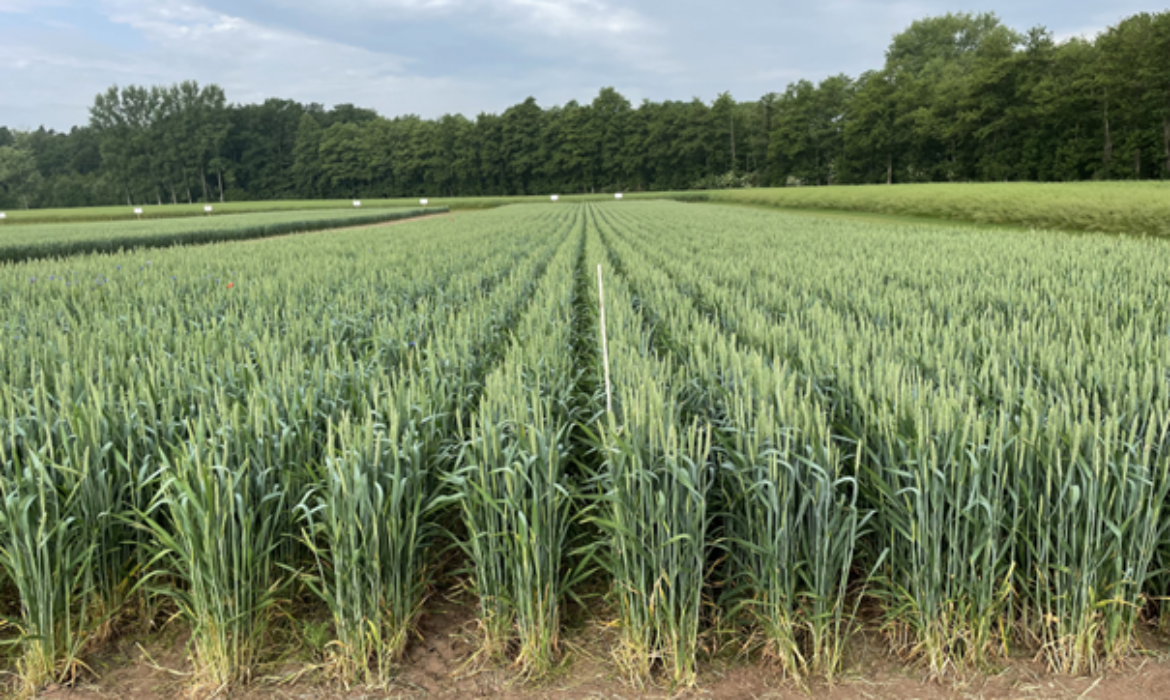
Giving priority to biodiversity – how much yield did it cost?
After we treated the companion plants relatively defensively in the first years, we wanted to give priority to biodiversity for the winter wheat 2022/2023. The sowing of wild herbs in the CRF system without the application of herbicide in the intermediate area was a benefit for wildlife but a challenge from the point of view of the conventional farmer.
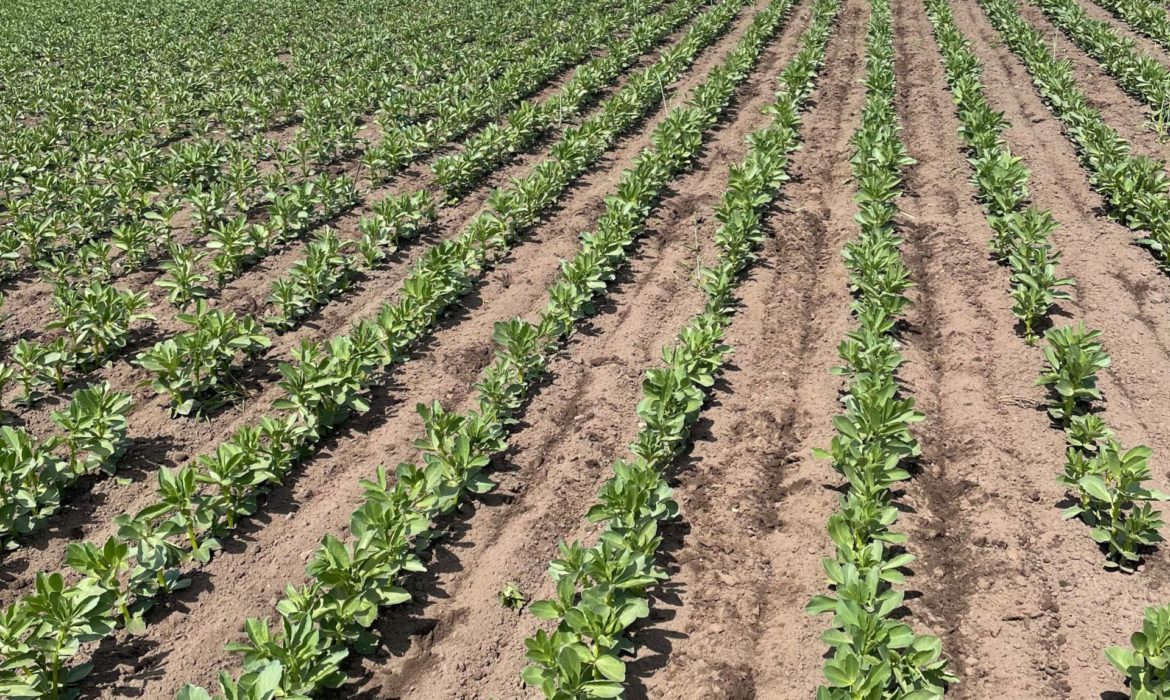
Cultivation year 2022 – The field bean is also adaptable
In addition to the demo trial at Gut Wambergen, a randomised field trial was also conducted in the region in cultivation year 2022, in order to provide a more detailed analysis of the CRF concept. A trial site with three repetitions on a sufficiently large area was needed to clarify in detail how the broad bean behaves in the CRF system. The trial was carried out as part of a master’s thesis supervised by the University of Applied Sciences, Soest.

Weed management in oats – clear insights
On 19th March 2022, oats of the Lion variety were sown in the Controlled Row Farming trial at Gut Wambergen. Interesting insights into the various control strategies against weeds were obtained after the harvest.
The cultivation system follows the same principle of the last few years:
- Standard (A) with 12.5 cm row spacing and 300 seeds/sq m – with the usual full-width spraying
- Modern (B) with 25 cm row spacing and 200 seeds/sq m – with the usual full-width spraying
- CRF-reduced (C) with double row at 50 cm and 2 x 12.5 cm row spacing and 200 seeds/sq m – with hoe, undersown crop and band spraying
- CRF-optimised (D) with double row at 50 cm and 2 x 12.5 cm row spacing and 200 seeds/sq m – with the usual full-width spraying

Oats: CRF-reduced (C) with double row at 50 cm and 2 x 12.5 cm row spacing and 200 seeds/sq m
In accordance with the strategy which is usual in the region, 50 g/ha Pointer Plus and 1 l/ha U46M were applied to all variants on 28th April for weed control. The application was full-width in variants A, B and D. The identical spray rate per hectare was applied as a band spray in variant C. With a band width of 20 cm, we achieved herbicide savings of 60 %.

Full-width plant protection in oats in variant Standard (A) on 28th April 2022
UX 5200 Super with 27 metre Super-L boom
On the same date, hoeing was carried out in a single pass, band application of the herbicide on the double row was provided and 18 kg/ha of red clover was sown in the 30 cm intermediate area.
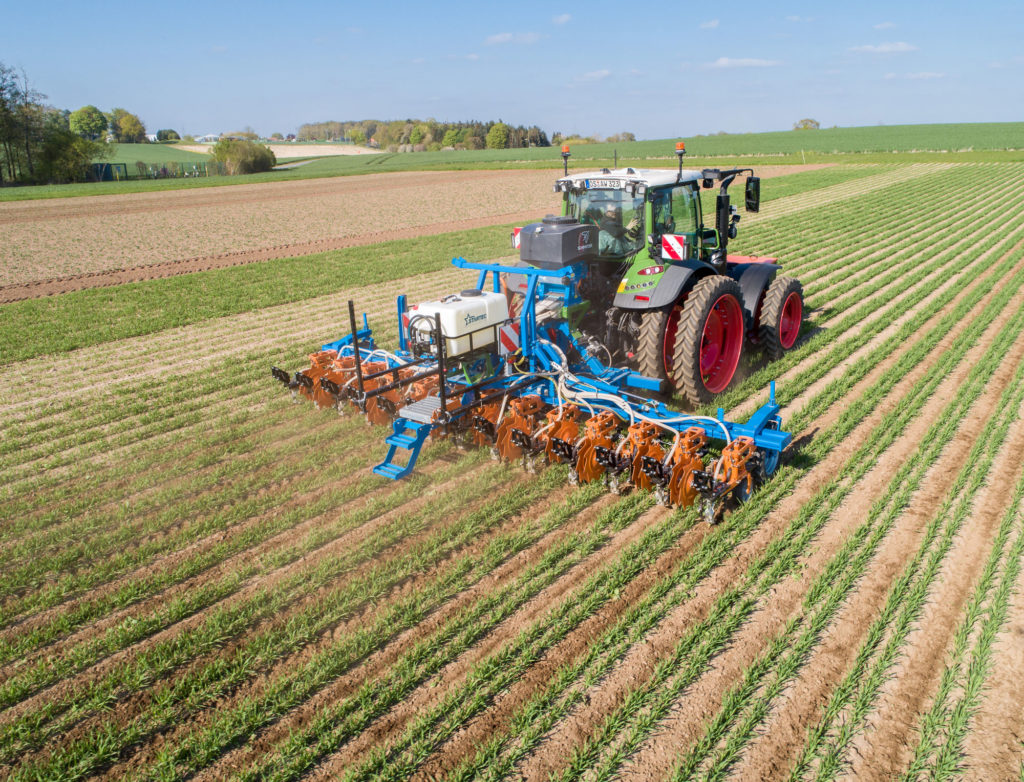
Mechanical weed control with band application and undersown crop in variant “CRF modern“ (C) on 28th April 2022, Schmotzer Select hoe 12 x 50 cm with Startec mounted sprayer and Greendrill 300
In addition, an application of fungicide and growth regulator was provided on 15th May. This application was not varied in the trial.
Field emergence was delayed and the competitive vigour of the oats was strong owing to the dry conditions after hoeing. The promotion of biodiversity was not very successful in the main growth phase of this summer cereal.
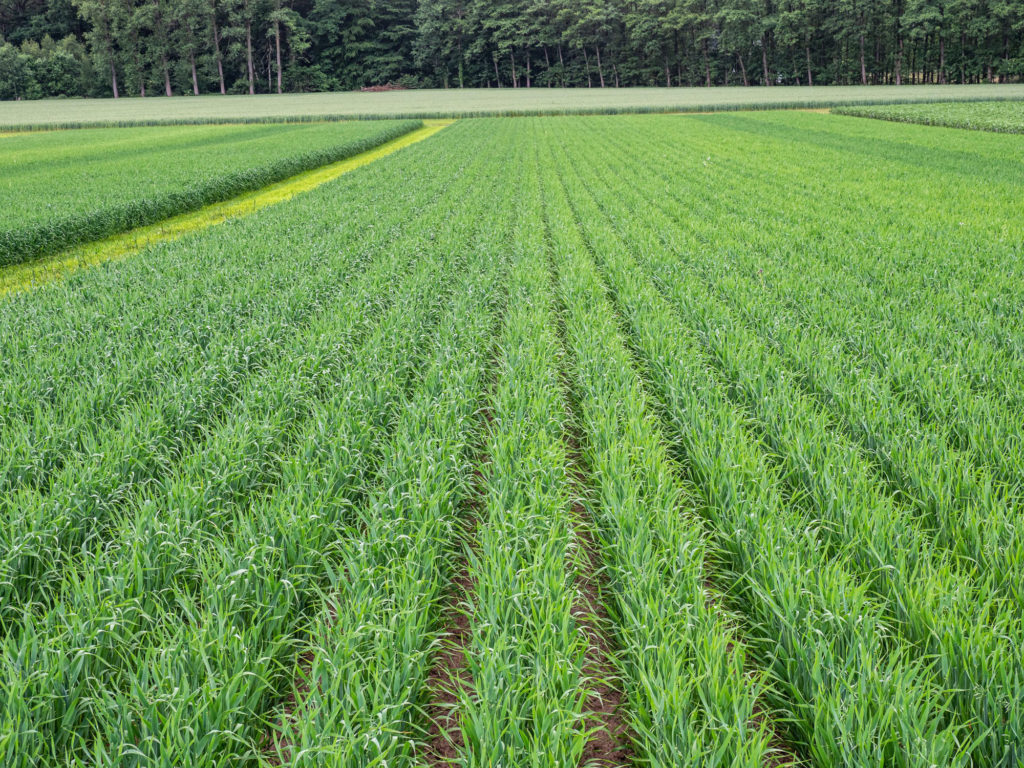
Oats in “CRF-reduced” (C) on 31st May 2022
The appearance of the trial variants after the harvest is all the more interesting. The oats were threshed on 25th July with yields of around 70 dt/ha.
The increased emergence of annual meadow grass (Poa annua) in some variants after the harvest is conspicuous. Annual meadow grass is a problem weed on this site and is not completely controlled by the herbicide used.
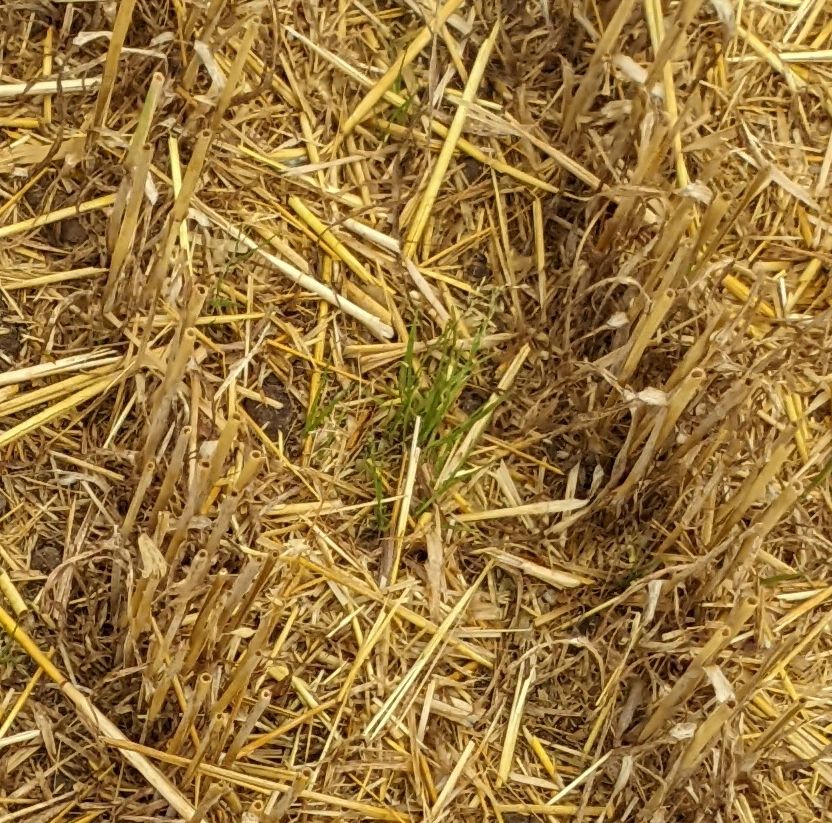
Annual meadow grass in the oat stubble
Extremely low weed persistence is apparent in the customary “Standard“ variant. As is known, oats suppress weeds very well at close row spacings.
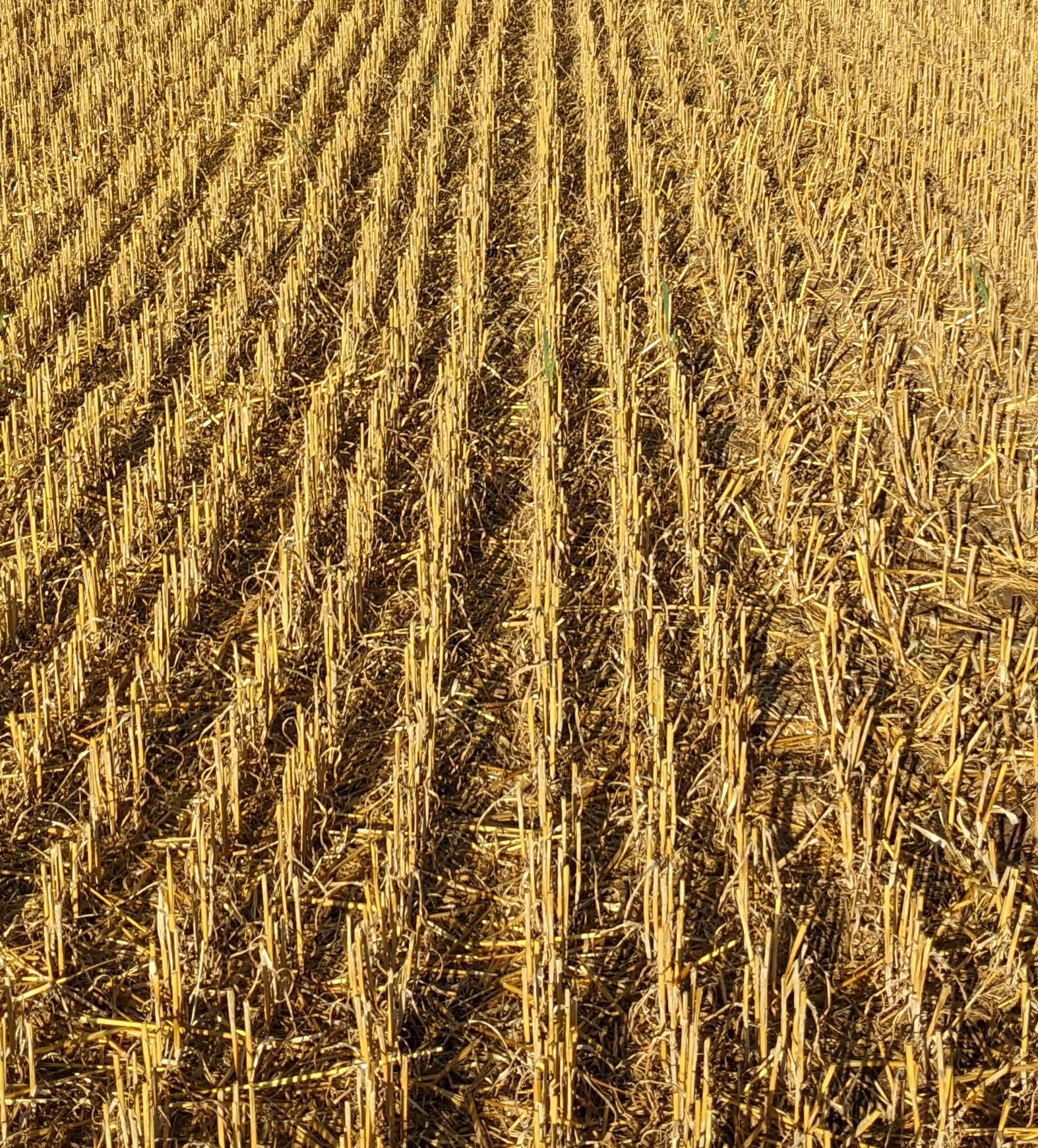
Oat stubble with 12.5 cm row width (A) on 28th August 2022
The population of annual meadow grass is worth controlling in variant B with a 25 cm row spacing. With the same herbicide application, it can be assumed that the greater and longer light incidence promoted the growth of the meadow grass. Shallow soil tillage or a total herbicide after the harvest would be appropriate, in order to prevent the spread of the meadow grass.
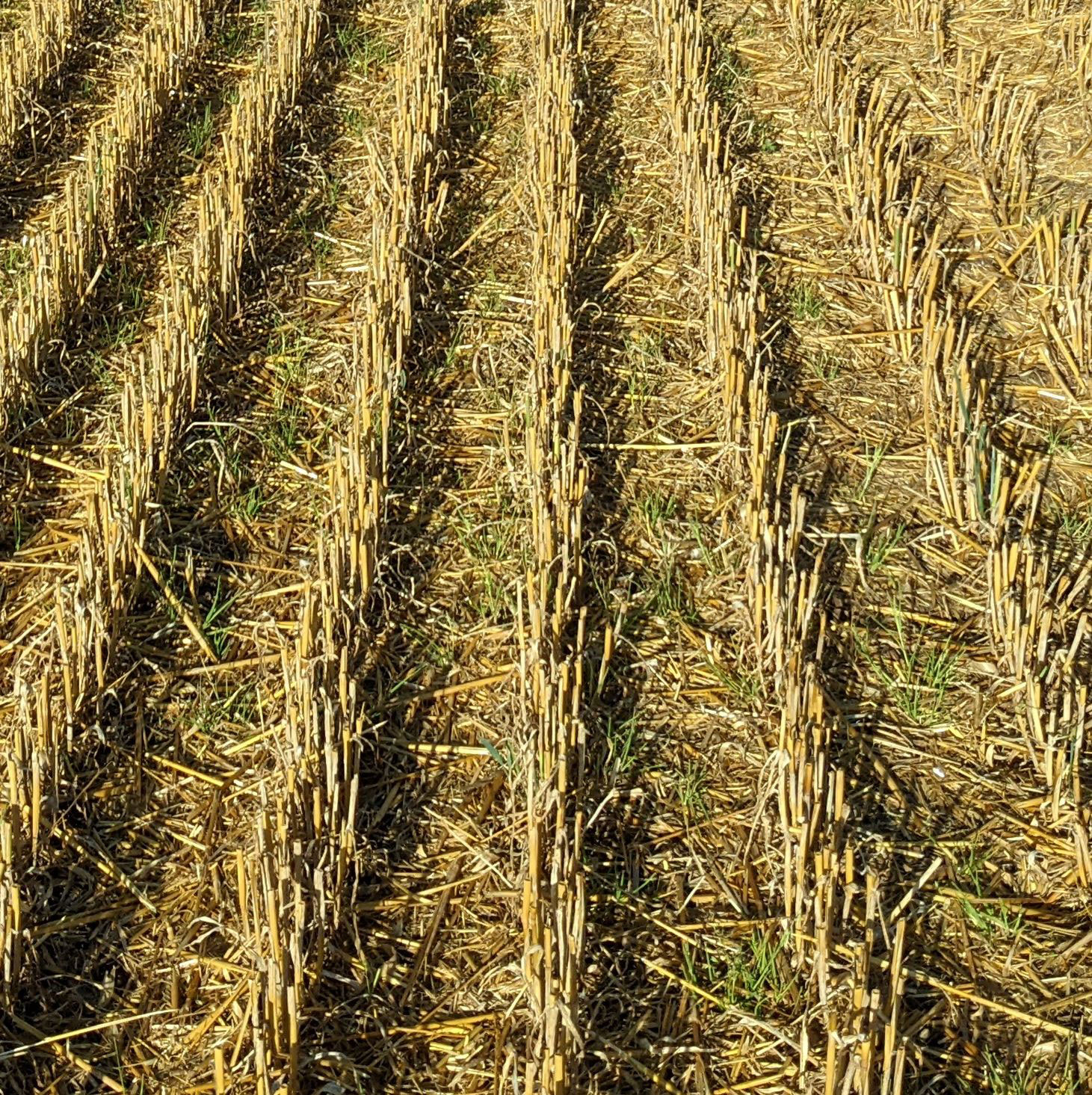
Oat stubble with 25 cm row width (B) on 28th August 2022
The red clover established itself surprisingly well in variant C. It can be assumed that it had sufficiently germinated and initially developed only very slowly under the oats. Heavy rainfall of 38 mm just before the harvest on 21st July then undoubtedly helped the increasing light to be used in the ripening crop.
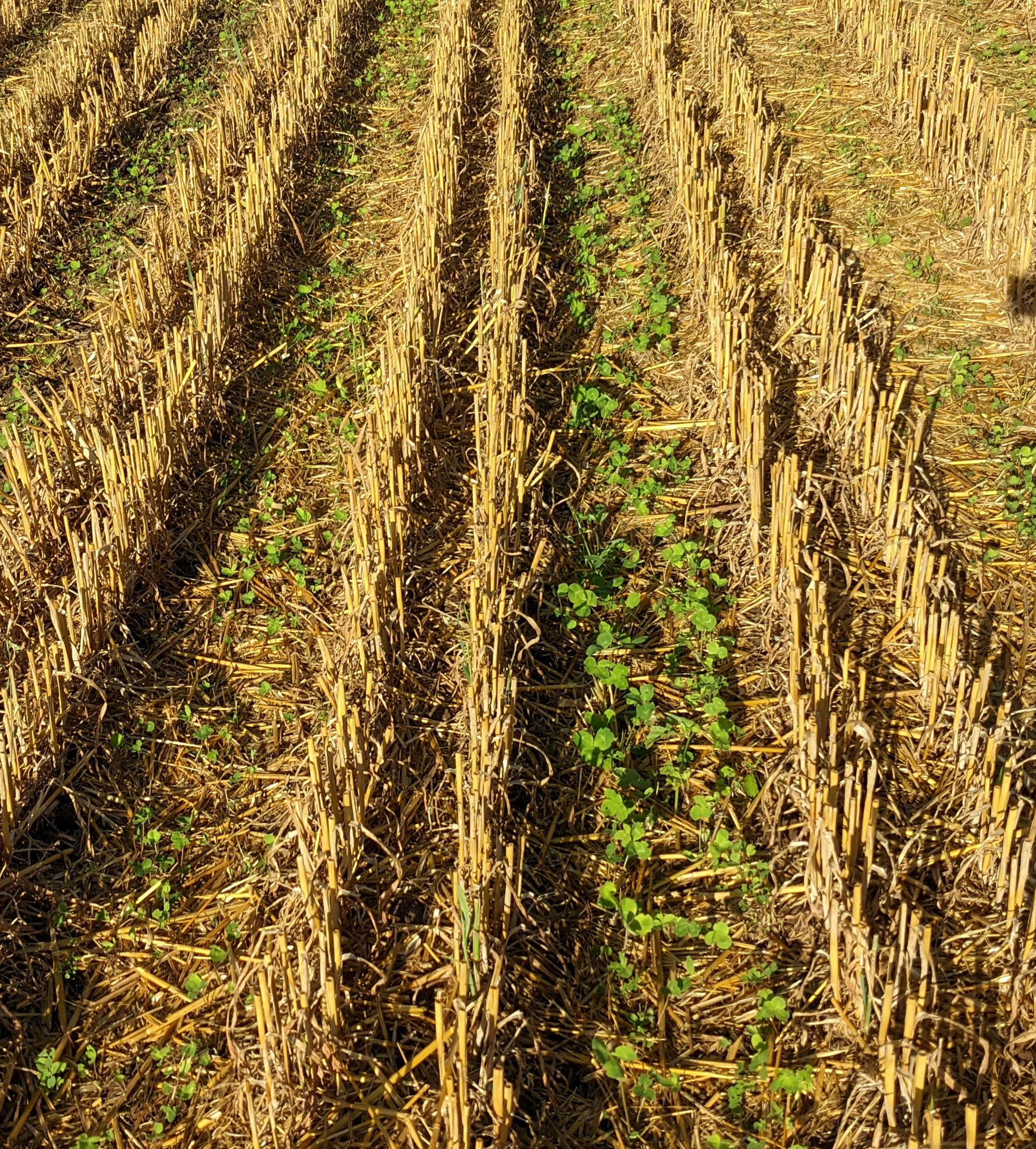
Oat stubble with 50 cm double row after hoe and undersown crop (C) on 28th August 2022
The advantages of a combined control strategy are apparent in variant C with double row at 50 cm and 12,5 cm row spacing. Only red clover and no annual meadow grass can be found in the working range of the hoe. The meadow grass undoubtedly emerged at the same time as the oats and would have spread as in variant B or D. The use of the hoe on 28th April was ideal,as it removed the annual meadow grass. The red clover established itself and the close row spacing in the double row in combination with band application of the herbicide suppressed the meadow grass very well. Annual meadow grass can occasionally be seen in the transitional area of the hoe and band sprayer. The meadow grass was obviously promoted by the intense light incidence at the edge of the double row. The hoe share could not reach several plants close to the row.
The annual meadow grass remains below the control threshold after the harvest in variant C. Weed control was extremely successful with a 60% reduction in herbicide use.
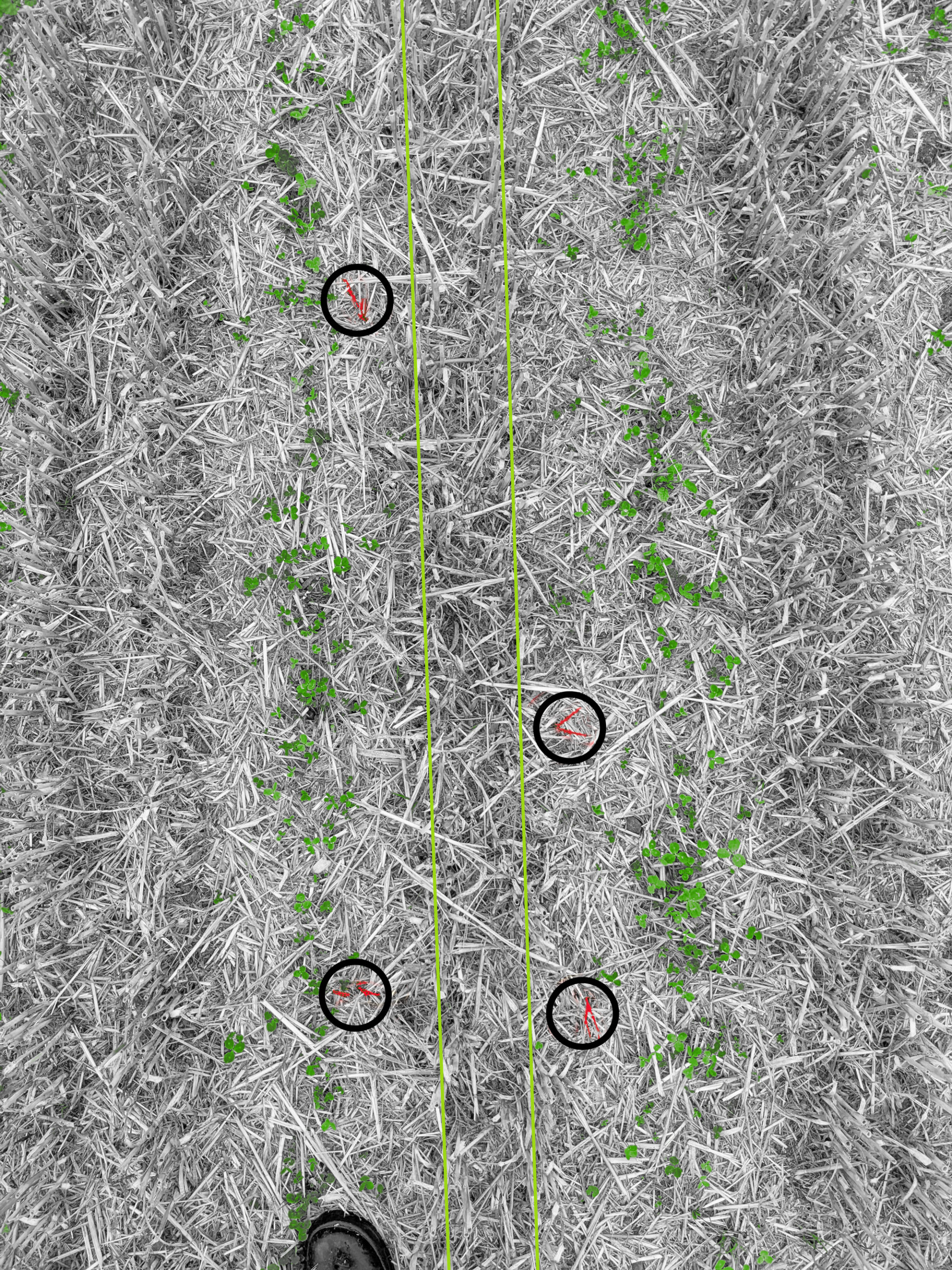
Oat stubble with 50 cm double row after hoeing and undersown red clover (C) on 28th August 2022
Green lines: Oat stubble in the double row
Red plants: Annual meadow grass
The same problems as in variant B with 25cm row spacing become apparent in the double row without use of the hoe. The meadow grass was able to establish itself and should be immediately removed for the purposes of field hygiene.
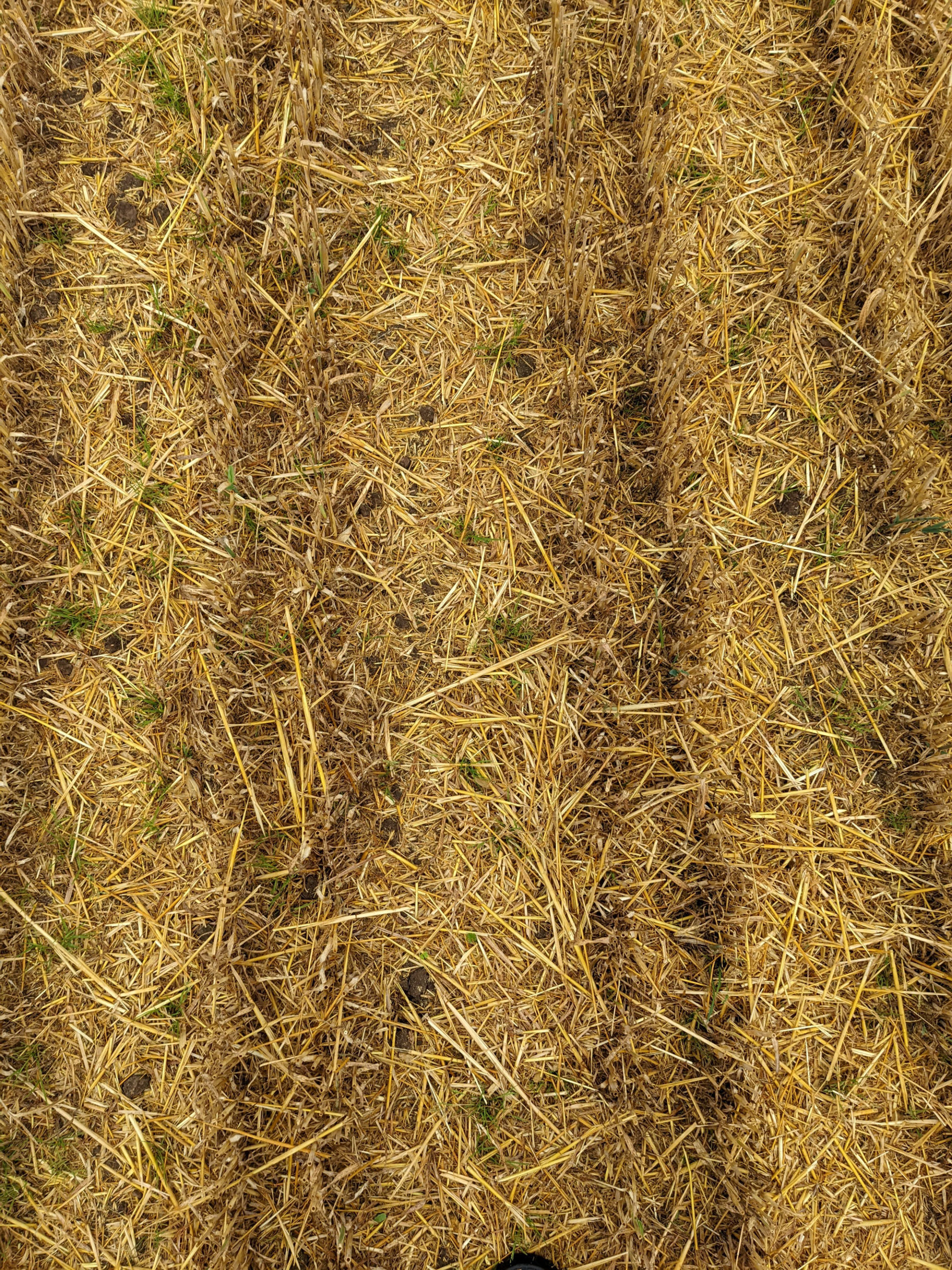
Oat stubble with 50 cm double row with full-width spraying (variant D) on 28th August 2022
The weather conditions indicate relatively well distributed precipitation. The good field capacity of the soil always provided the oats with sufficient moisture and produced good yields of 70 dt/ha.

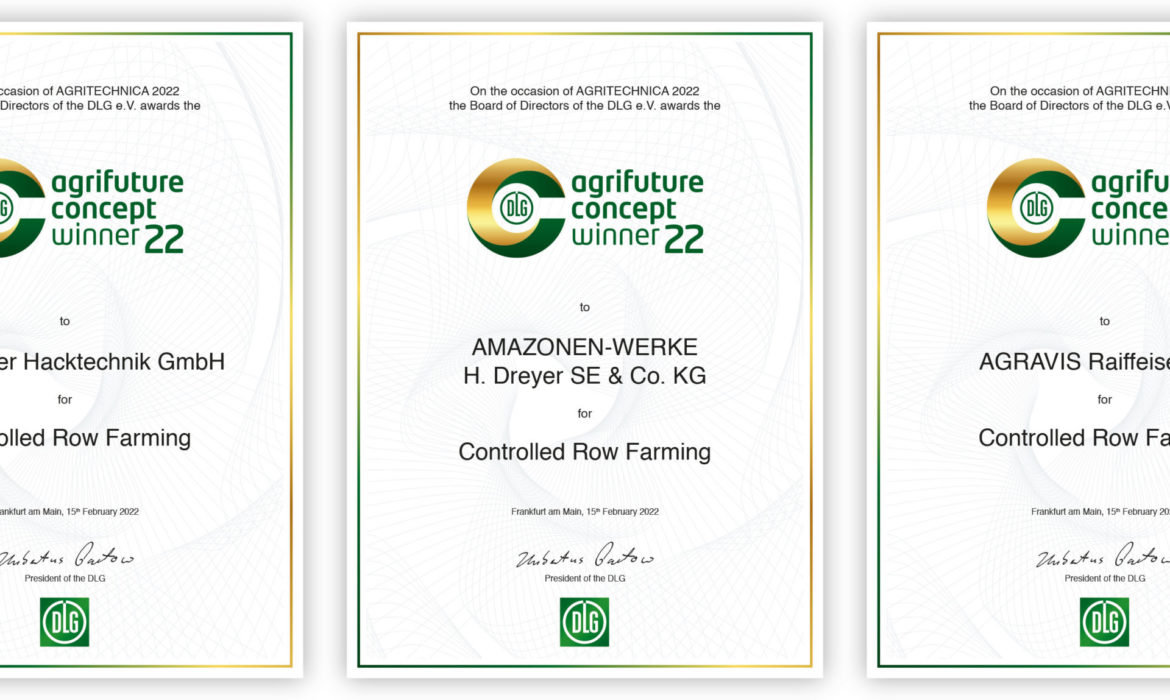
DLG-Agrifuture Concept Winner 2022
The “DLG-Agrifuture Concepts” innovation prize for pioneering achievements and visions for the future in agricultural technology was awarded for the first time during Agritechnica. The “CRF – Controlled Row Farming” farming concept from Amazone, Agravis Raiffeisen and Schmotzer Hacktechnik was chosen as one of the winners from a shortlist of ten nominated innovations. The jury of independent international experts appointed by the DLG (German Agricultural Society) thereby recognised the new arable farming system for promoting biodiversity through cultivation with uniform row widths.
The DLG is supporting pioneering concepts for the future of global crop production with this new award. The award ceremony took place on 15th February 2022 as part of an online event.
Link to the DLG press release: https://www.dlg.org/de/landwirtschaft/presse/aktuell#!/news/dlg-agrifuture-concept-winner-2022-die-preistraeger-fuer-den-neuen-zukunftspreis-agrartechnik
Link to the Agritechnica website: https://www.agritechnica.com/en/agrifuture-concept-winner/winners-2022
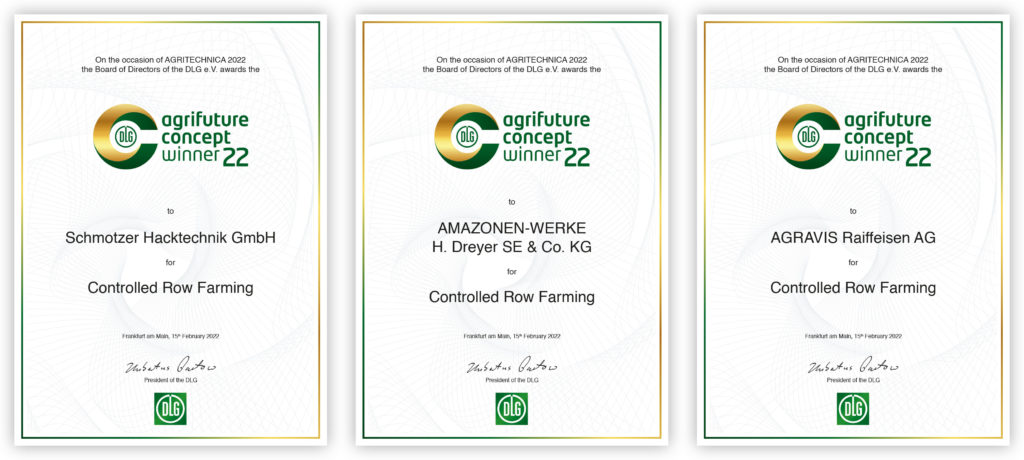
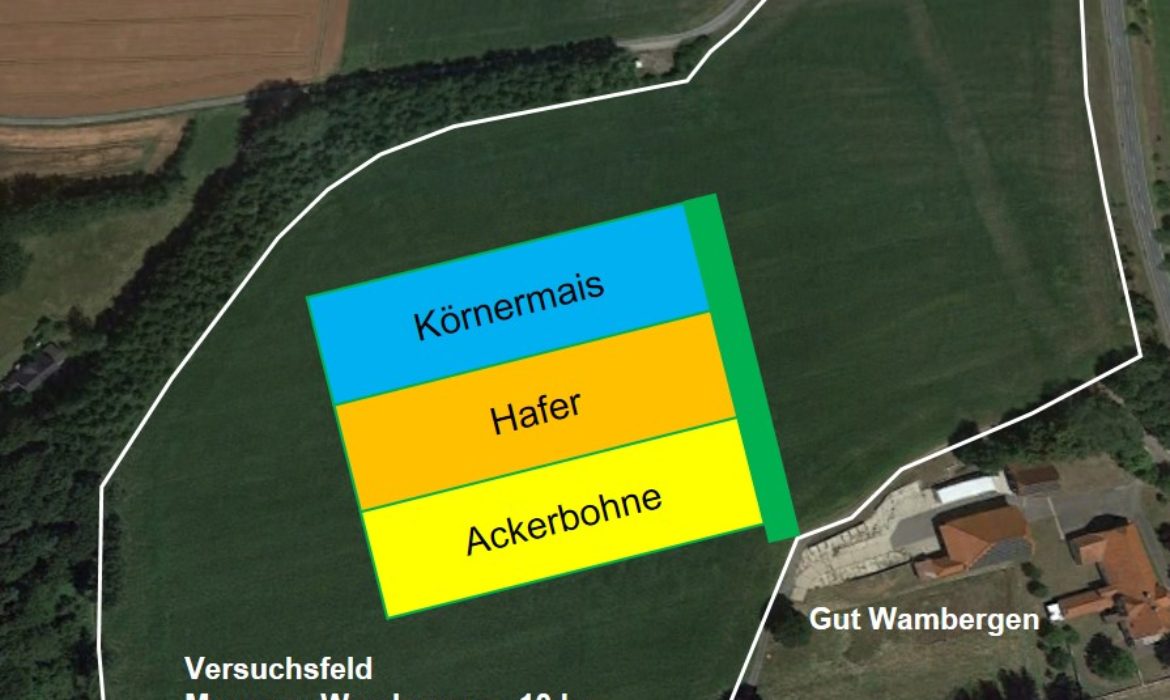
Crop season plan 2022
Three summer crops will be grown in the cultivation year 2022: broad beans, oats and grain maize. The plots were restructured, and a uniform basis was created with a plough furrow.
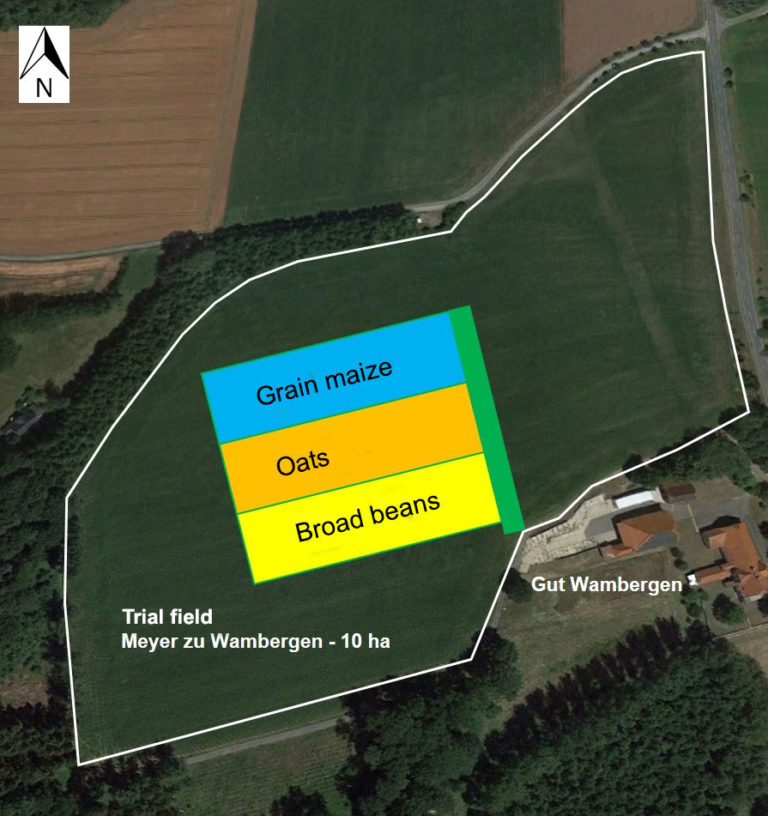
Broad beans and oats will be sown with a Centaya drill combination with a 12.5 cm row width in the standard variant. The row width will be doubled to 25 cm in the modern variant. The sowing rate of the oats and broad beans will be reduced by 1/3, so that the seed gaps in the row are not too small. The seed rate will not be varied for maize since the individual plants cannot tiller and compensate for this.
The reduced seed rates will also be used in the two CRF variants. The distribution in the field is the only difference, because two rows are closed in the CRF system and a double row is then sown with 12.5 cm. We have reduced the seed rate of winter cereals by 50% in the modern variant and the CRF variants in recent years – with good results (see winter barley 2021).
The CRF variants will also be sown as double rows with the drill combination for oats. This would also be possible with the broad beans. We thought it would be more interesting to sow 50 cm rows with a precision air seeder. We will see how the crops develop with the same seed rate compared to the modern variant.
We decided to use red clover as a companion crop in the oats in the reduced CRF variant. The red clover will be sown as early as possible in combination with band spraying. It is vigorous and should establish itself intensively. Mechanical reduction with a row-specific roller will be possible if it endangers the maturation of the oats.
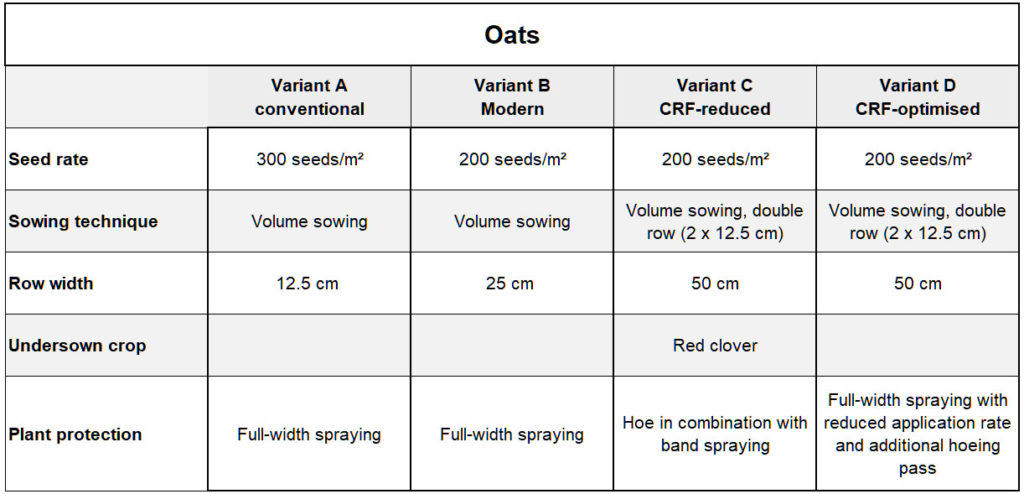
The pre-emergence spraying in the broad beans will be provided by band application. Persian clover will be sown in the first hoeing pass. This is a low-growing crop and should not disturb the broad beans too much until harvest. Reduced crop protection treatment will be applied over the entire area in the optimised CRF variant, in order to give the broad beans a head start. The hoe will potentially be applied twice, in order to suppress weed competition.
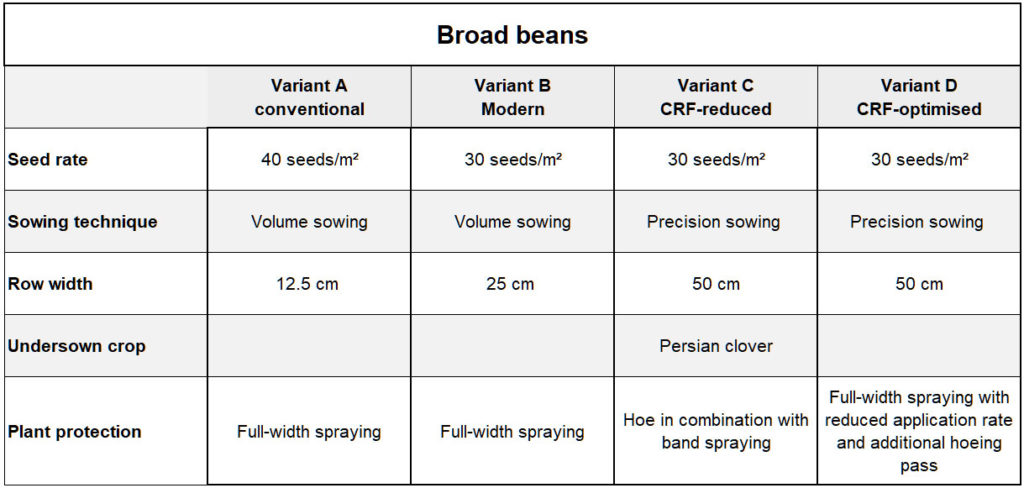
The Precea precision air seeder will be used to sow the grain maize at 75 cm in both the standard variant and the modern variant. The seed will be sown at 50 cm in the two CRF variants.
The herbicide will be applied in the modern variant with a reduced amount of soil herbicide, in order to permit an undersown crop. As hardy ryegrass could become problematic in the crop rotation, bristle oat was selected as a frost-intolerant undersown crop. The undersown crop increases biodiversity and improves accessibility during the harvest. The mulch offers good protection against erosion over the winter.
The full herbicide mixture in the CRF-reduced variant is used in the same way as in the conventional variant but will be applied by band spraying. It will be interesting to see whether the bristle oat undersown crop develops better in the herbicide-free intermediate area than in the modern variant.
A full-area, somewhat weaker herbicide mixture will be used in the CRF-optimised variant, in order to give the maize a head start. Depending on the weather conditions, 1-2 additional passes will be made with the hoe.
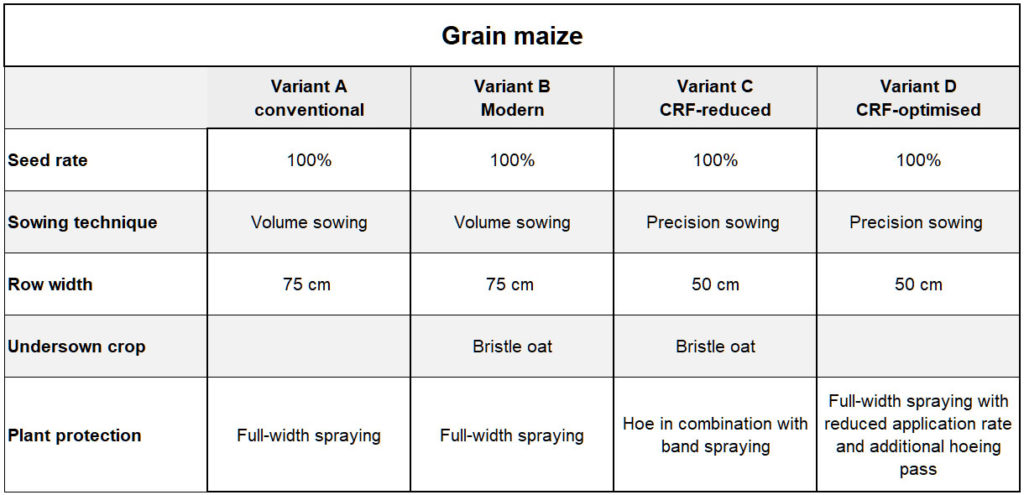
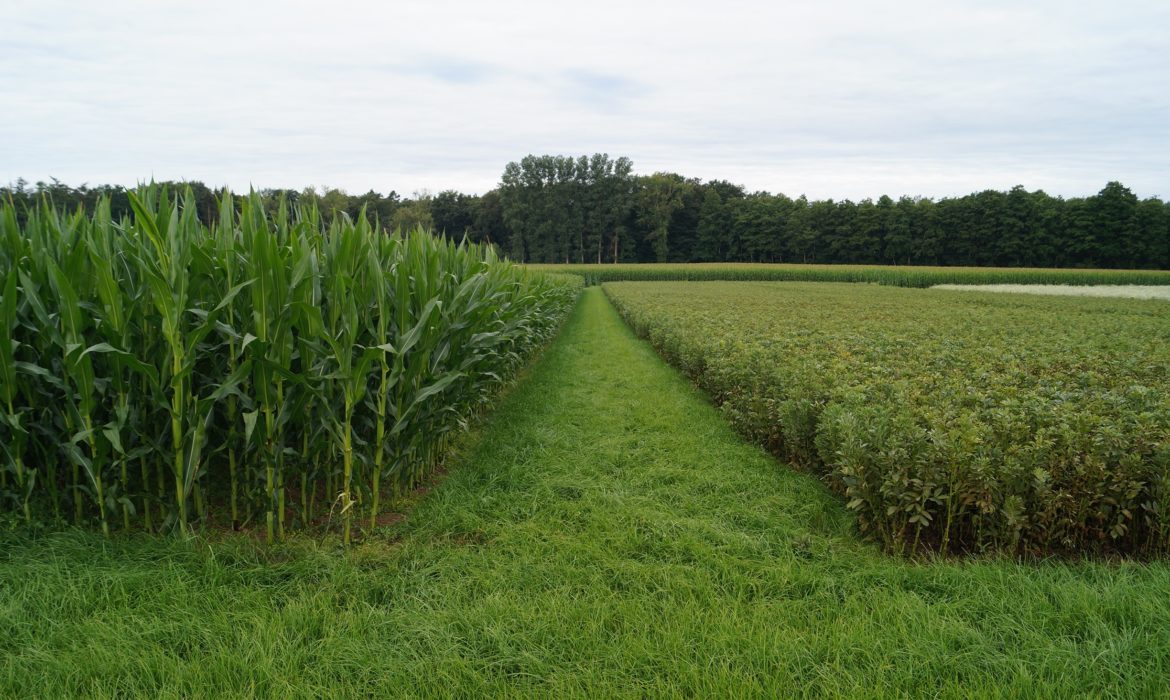
Field trials at Wambergen
The Controlled Row Farming method of cultivation is being tested on a trial area in the immediate vicinity of the AMAZONEN-WERKE factory in Hasbergen-Gaste.
The trials are for demonstration purposes and, following initial tests in 2020/2021, are now being set up in a structure which can be sustained in the long term. The trial design is adapted to the 27-metre tramline system of the partner company which manages the land in Wambergen.
Three crops are grown each year on the 3 ha trial area in a 10 ha field, in order to make the trial attractive to visitors. Each crop has four variants with a width of 12 metres. This makes it possible to repeat plant appraisals over a length of approx. 150 metres and to record crop yields by means of core threshing. The 12-metre wide plots allow working widths of three and six metres for sowing and cultivation.
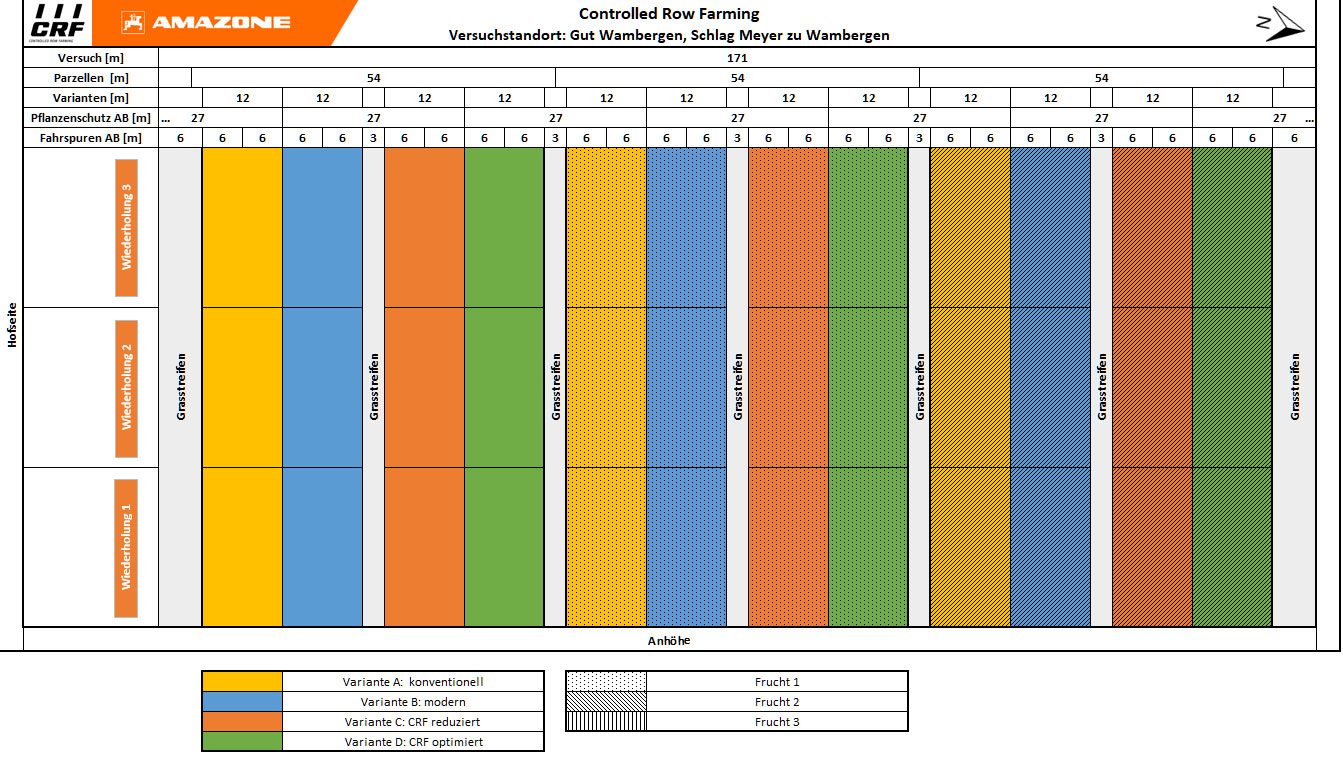
The four trial variants Standard (A), Modern (B), CRF-reduced (C) and CRF-optimised (D) are laid out in the form of simple strips. Randomisation is not possible at this location in the arrangement with series technology.
Standard: This trial variant demonstrates the conventional, classical cultivation customary in the region. It provides a realistic opportunity to measure or compare the different trial variants against this conventional variant.
Modern: The “modern variant” is cultivated with the usual land management and extended by current and innovative plant cultivation measures. These could be alternative row widths and seed rates, undersown crops or alternative plant protection strategies.
CRF-reduced: The aim of the CRF-reduced variant is to put the companion plants in the foreground and to devote particular attention to the promotion of biodiversity with a reduced use of inputs. The row spacing of 50 cm is provided in single or double rows, depending on the crop. The companion plants in the intermediate area should develop early and intensively. Depending on the crop and the seasonal weather conditions, the companion plants can be mechanically reduced in the rows, in order not to endanger the maturity and threshability of the main crop.
CRF-optimised: The CRF-optimised variant pursues the goal of keeping yields stable with optimised input costs. The inputs can be applied exclusively in the row by sowing with a row spacing of 50 cm, which is identical to the CRF-reduced variant.
Sowing, mechanical cultivation measures and band spraying are carried out with 6-metre working widths using RTK-guided tractors. Sowing with a working width of 3 metres and hoeing with a working width of 6 metres are possible as we do not have to hoe “to the last centimetre” in the row in the conventional system.
A standard 27-metre crop protection sprayer is used on the 3-metre grass strip outside the actual trial site for full-area plant protection. The machine can run different applications on a plot-by-plot basis by switching off the part-width sections. Row-specific nozzle technology or drag hose systems for liquid fertilisation can also be used in the 50cm CRF system.
A complete plot can also be fertilised with granulated material via the lateral grass strips with a twin disc fertiliser spreader. The new Border-TS border spreading system provides excellent lateral distribution within the 27 metres. The use of a pneumatic spreader, which is often used in field trials, is not necessary.
The grass strips have the advantage of being easy to drive over all year round and are also easy to access during field inspections.
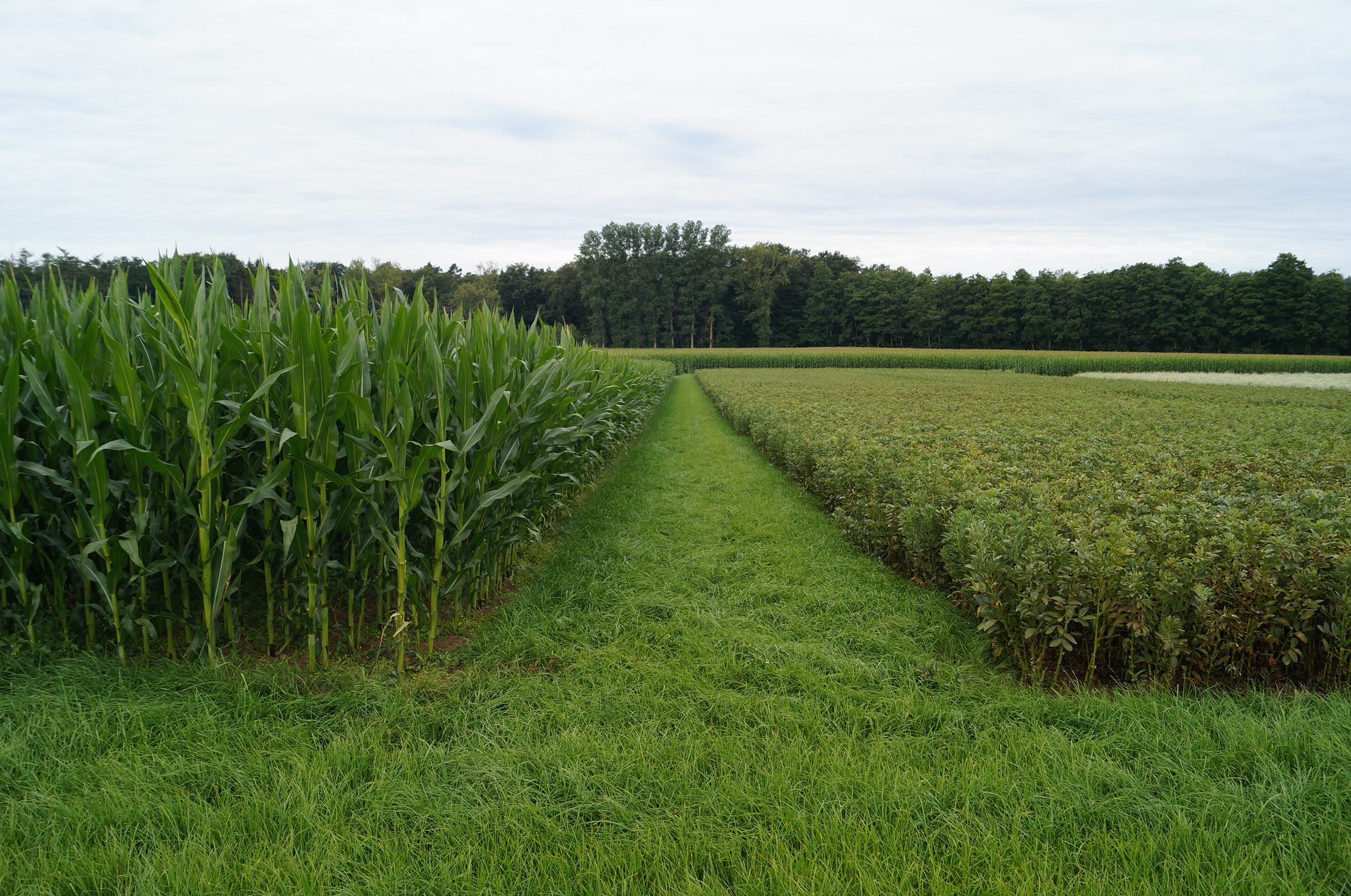

Economic consideration of the Controlled Row Farming system
Apart from the practical implementation of the Controlled Row Farming method with regard to the plant cultivation and ecological effects, the question of economic viability also arises. How does the increased financial expenditure for technology, labour and time required in this alternative arable farming system compare to the savings, especially for fertilisers and plant protection agents?
We see the medium-sized arable farms of Western Europe as the target group for the method. A fictitious 350-hectare arable farm in the Börd landscape south of Hanover serves as the basis for the following considerations. We calculated alternative scenarios together with a student work group from the Osnabrück University of Applied Sciences.
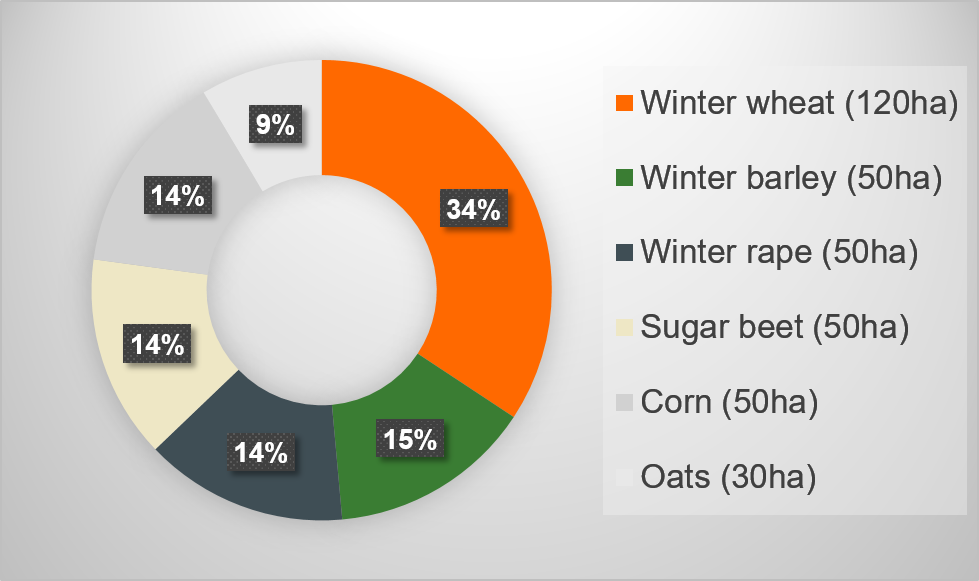
Mechanisation for application of the CRF system
The initial situation is assumed to be the usual regional mechanisation in a 27-metre tramline system: A plough, cultivator and compact disc harrow can be used with a 200 hp tractor. A 3-metre sowing combination with active tillage, a precision air seeder, a mounted fertiliser spreader and a trailed field sprayer are common equipment on a farm with a tradition of good revenues from sugar beet.
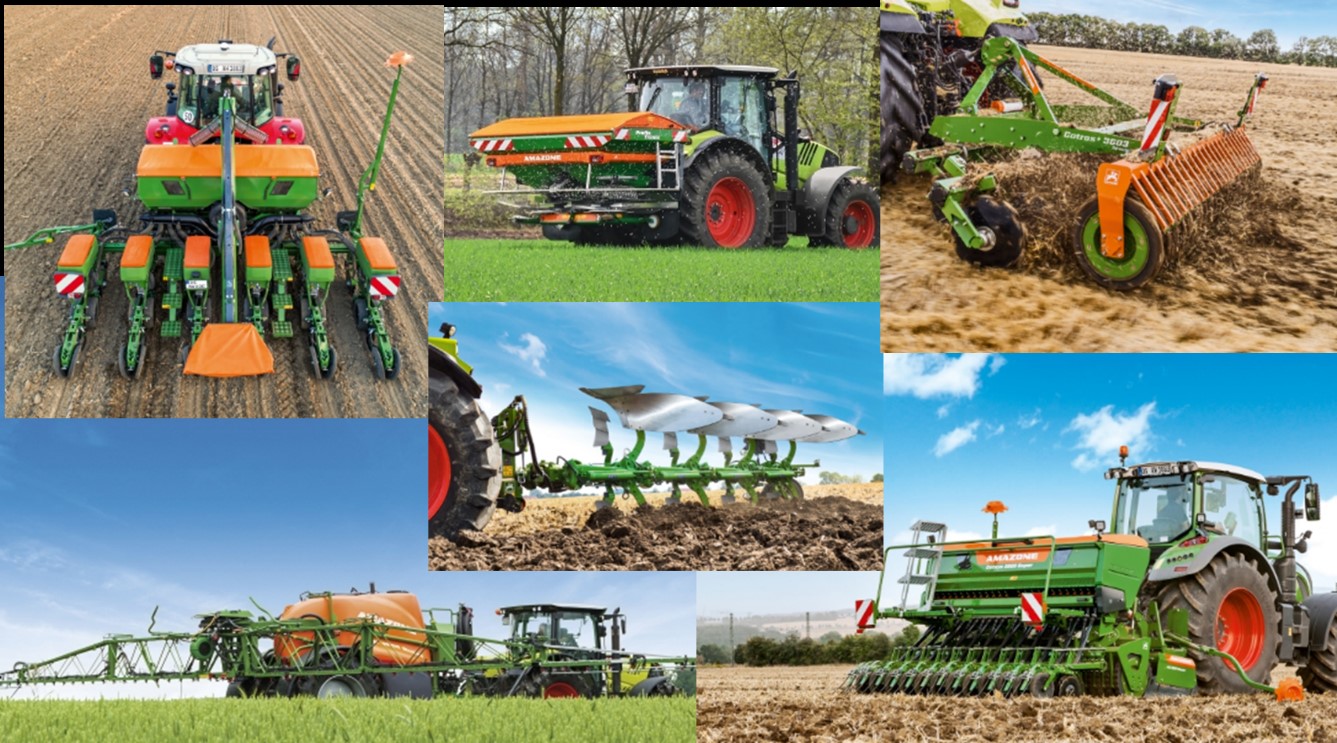
When converting to the CRF system, the focus is on reorienting the entire farm to 6-metre sowing and hoeing technology. Various implements can be supplied via the FTender 1600 front tank: Cereal seed coulter with 12 double rows and TwinTec coulters with a 15 cm spacing. The 12-row precision air seeder can be used to apply under-root fertilisation via the front tank, and the 12-row hoeing technology can be used to apply undersown crops. A strip-till cultivator with variable, row-specific 25 or 50 cm spacing, which could be used to deposit fertiliser from the Ftender, under the surface, has not yet been considered but is foreseen in the system.
Precise band spraying integrated in the hoeing technology is also at the heart of the system. The FT-P 1502 front tank and the row spraying device are therefore part of the mandatory equipment. The UX 4200 Special trailed sprayer with 27 m is replaced by an UF 1302 mounted sprayer with 18 m, in order to continue to make the most of the front tank. In combination with the FT-P 1502, the tank is large enough to achieve acceptable acreage output.
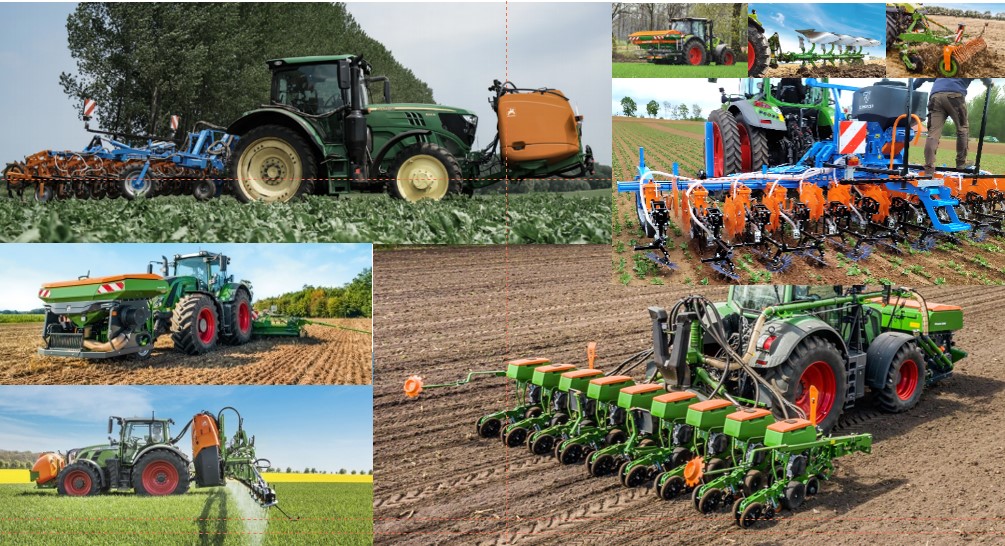
Other tramline systems and mechanisation are also conceivable. For example, band spraying with a conventional trailed sprayer (see AmaSelect row) is also possible. This has a significantly higher acreage output but does not provide the precision of an integrated band spraying system.
Cooperation with neighbouring farms in the inter-farm use of fertiliser and crop protection technology can also be appropriate if the bulk of the applications are placed row-specifically and the utilisation of the farmer’s own standard machines is thereby unduly reduced.
Economic benefits of the effects of the CRF system
The core of the CRF system is the row-oriented placement of as many inputs as possible. Herbicide savings are very easy to examine. If the band width is 10 cm for crops in single rows (maize, sugar beet, rape) and 20 cm for double rows in cereals, a 50 cm row width results in reductions of 80% and 60 % respectively. Savings of fungicides and insecticides are also conceivable in row-specific applications with e.g. droplegs. They were not considered in the initial calculations, as sufficient knowledge about plant cultivation is not yet available.
The increase in efficiency arising from placed fertilisation has been known about for years, especially for maize. It is also increasingly being used for the seedling development of cereals (see SingleShoot method). Further fertilisation measures will be applied row-specifically in the CRF system depending on the mode of action of the fertiliser type. Both the hoeing technology and the conventional sprayer open up various possibilities for placing solid and liquid fertilisers next to, on top of or under the row. We assumed that only the third application in cereals is applied across the full working width for this calculation, which means that only 26% of all fertilisation measures are applied across the full working width. We assumed a moderate increase in efficiency of the fertilisation measures of 10% at constant yields in the calculation.
Taken together, the above reduction potentials provide a cost reduction of 43 % or 64 € /ha for plant protection and 10 % or 10 € / ha for fertilisation.
The use of implements with smaller working widths and tanks for band spraying and fertiliser placement results in significantly lower outputs per hour, which have a negative economic impact. This results in an increase in machinery and labour costs of 63% or 14.945 € / year in the calculation.
On balance , however, it becomes clear that the absolute costs per hectare for the machinery increase less than the reduction in the costs of the plant protection agents. This is despite the fact that we set a very high hourly rate of 60 €/hour in the calculations for all work involved. Shifting the work from the farm manager to a part-time driver can bring additional reductions.
Sugar beet is a concrete example of this:
- The increase in machinery costs due to the use of hoe, front tank and band sprayer is 15 € / ha.
- The additional working time results in costs of just under 30 € / ha.
- This is mainly offset by the reduction in costs arising from herbicides – these total over 170 € / ha.
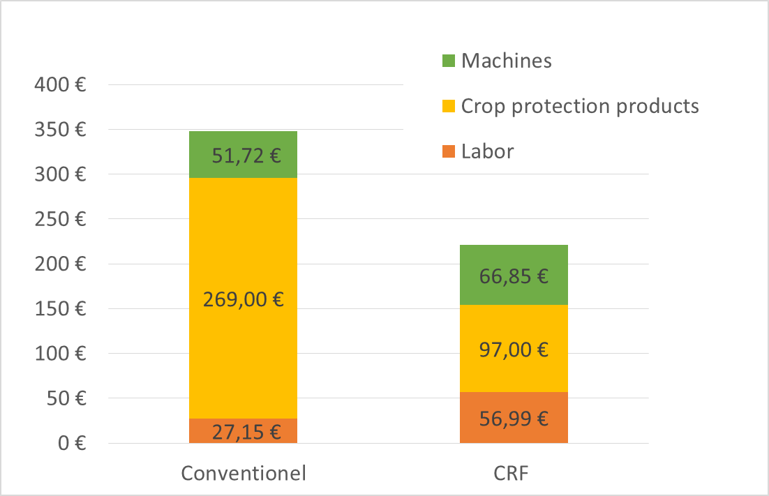
The balance varies greatly depending on the crops. The intensive use of herbicides in sugar beet brings clear cost advantages. There are slight advantages in maize and rape and the effects cancel each other out in cereals.
The costs of the CRF system are 1 % below the usual land management if the complete crop rotation of the 350 ha farm is considered.
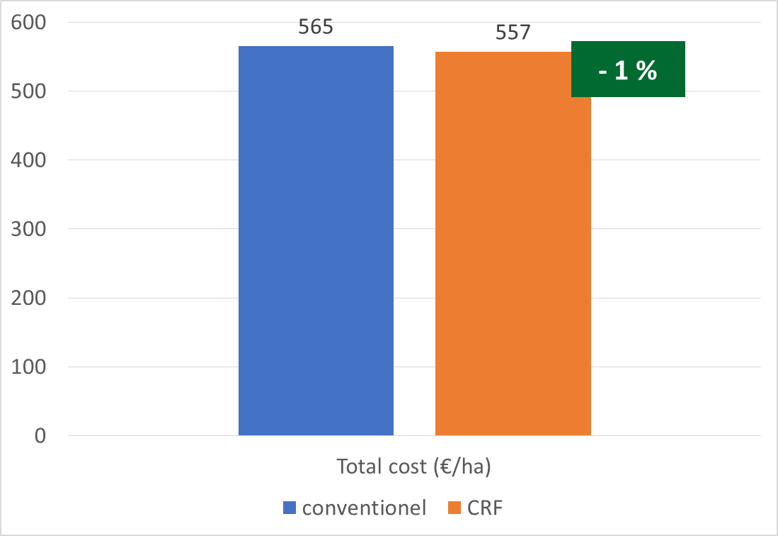
The challenge of working time
The change in mechanisation results in completely different outputs per hectare. The Amazone output calculator shows an output of 12.4 ha / hour for the initial situation with the UX 4200 Special, 27 metres, with a total annual output of 1370 ha. The conversion to herbicide band spraying with a hoe and the FT-P results in a required annual output for the combination of about 670 ha. With an output of 4.9 ha/hour, one of the main challenges of the CRF system becomes apparent. The usual full-width application is reduced to about 700 ha / year with an hourly output of the 18m mounted sprayer of 7.7 ha. The difference between the usual full-width spraying and the use of hoeing technology becomes more striking when the working time required for 120 ha is considered. The 27-metre sprayer requires approx. 10 hours, the 6-metre hoeing technology 24 hours.
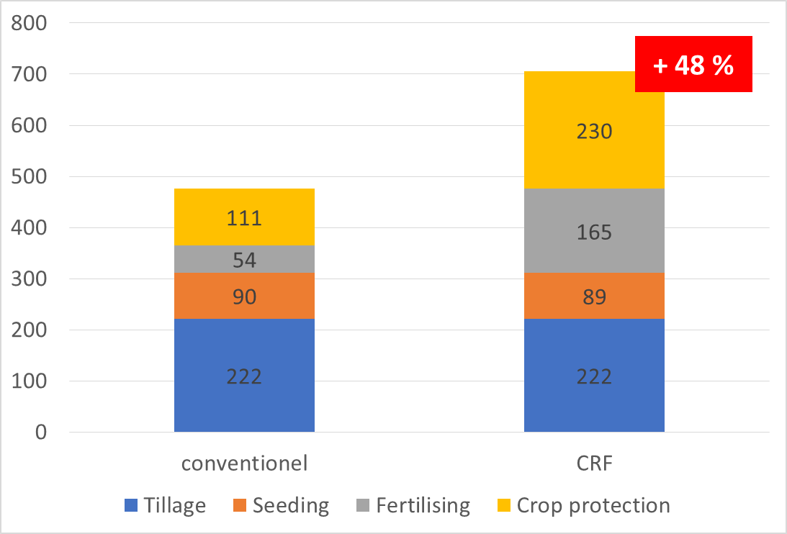
Adding together all operations over the complete crop rotation, including all downtimes such as transport and filling, shows an increase in the working time requirement of 48 %. This is a challenge from the point of view of regional difficulties in finding labour for agriculture and increasing labour costs. Sufficient labour is available from a global perspective, but it has not yet been possible to resolve this imbalance on a political level.
The increasing automation of work processes in connected implements (e.g. steering of the hoe, control of work quality with Argus Twin) leads to higher outputs per hour due to a reduction in the driver’s workload and higher forward speeds. As can be seen from the example of precision seeding (EDX, Precea), much has been done in recent years to maintain the quality of work, even at high speeds.
In the medium term, Controlled Row Farming would be ideally suited for a complete workforce of autonomous field robots, thereby solving the challenge posed by increased working time requirements. In this case, the working widths can become smaller again and the speeds decrease if the available working days permit this. This could potentially be of benefit to precision and work quality and, last but not least, lead to a reduction in diesel consumption per hectare.
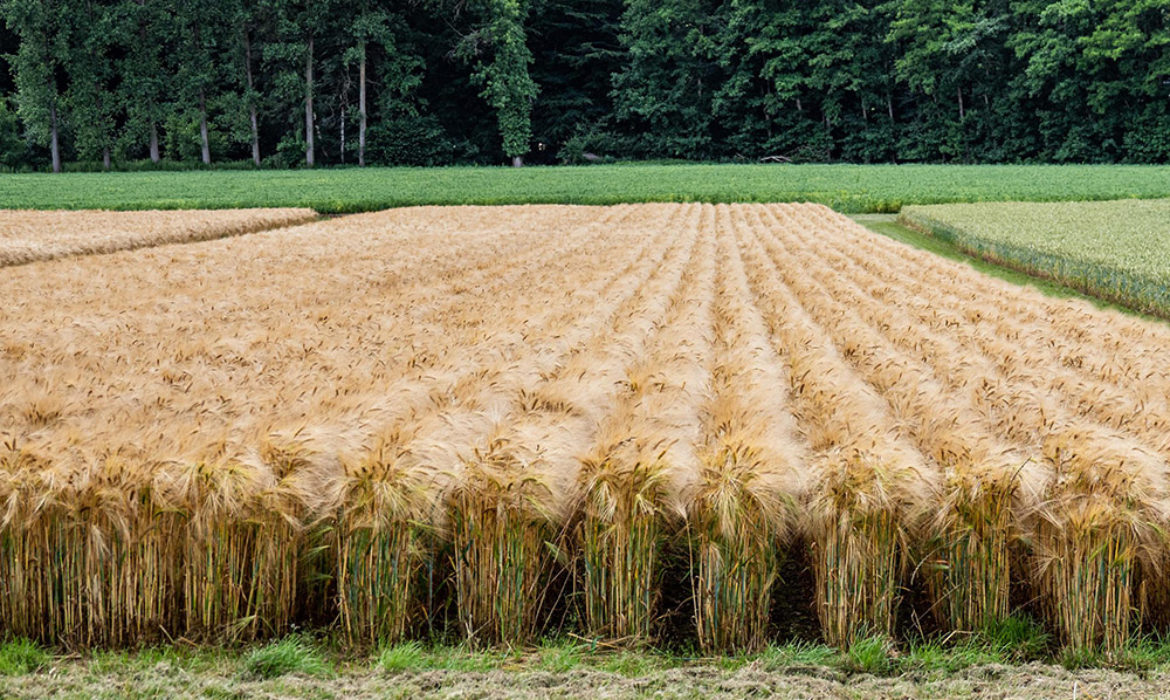
Cultivation year 2020/2021 – Winter barley
All winter barley trial variants produced the same yields in the 2021 harvest! There are also no differences between the double row with a 50 cm row width with undersowing and the other variants.
The winter barley “KWS Wallace” was sown on 04.10.2020. The sowing rate in the conventional variant was 310 germinable grains / sq m, with a row width of 12.5 cm. The theoretical seed gap within the groove was 2.58 cm. Only the seed rate was halved for the same row width in the modern variant. 155 gr/sq m resulted in a theoretical seed gap within the groove of 5.16 cm.
The two CRF variants were arranged identically: always two rows with 12.5 cm spacing and then two rows closed, in order to allow space for the companion crop with 50 cm spacing of the double row. The theoretical seed gap within the groove is 2.58 cm and is identical to the conventional variant.
Herbicide was applied to all variants over the full area on 04.11. for weed control. It was impossible to use a hoe because of regular rainfall in October. The alternative of band spraying in the autumn with an initial hoeing pass in early spring seemed very risky to us owing to a very high weed pressure. Fortunately, we have a level of flexibility in the CRF project and can solve particular challenges with full-area applications. We will try planting the undersown crop while sowing the main crop or shortly afterwards in the future.
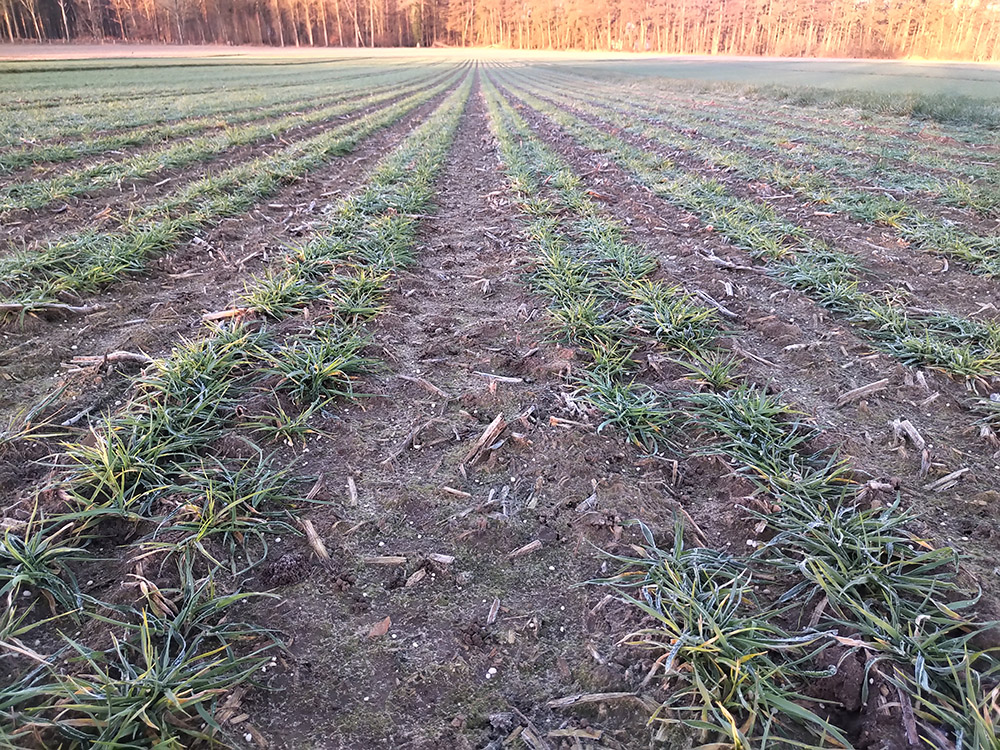
Further crop management with fertilisation and plant protection was the same for all variants. Details can be found in the following graphic.

Hoeing in combination with the sowing of Egyptian clover was carried out in the “CRF reduced” variant on 04.04.2021. The clover developed relatively slowly at first because of competition with the barley and the extremely cold spring. Even though it looked relatively good before harvest, the effect is relatively small in terms of promoting biodiversity. We plan to promote companion plants more aggressively next year.
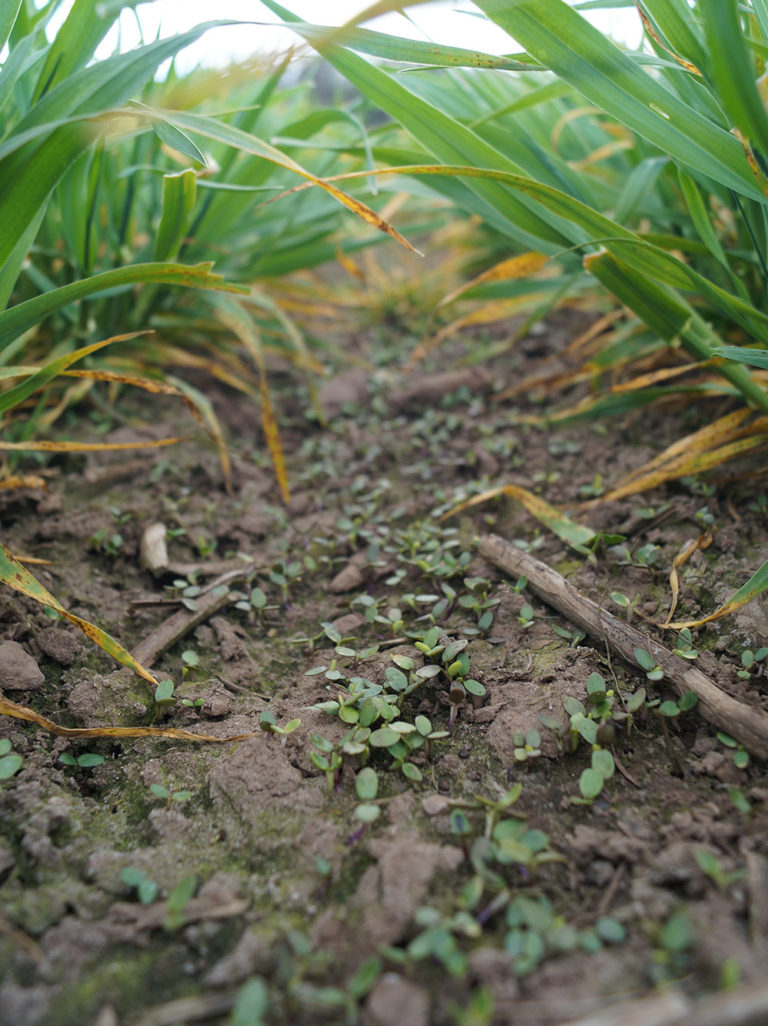
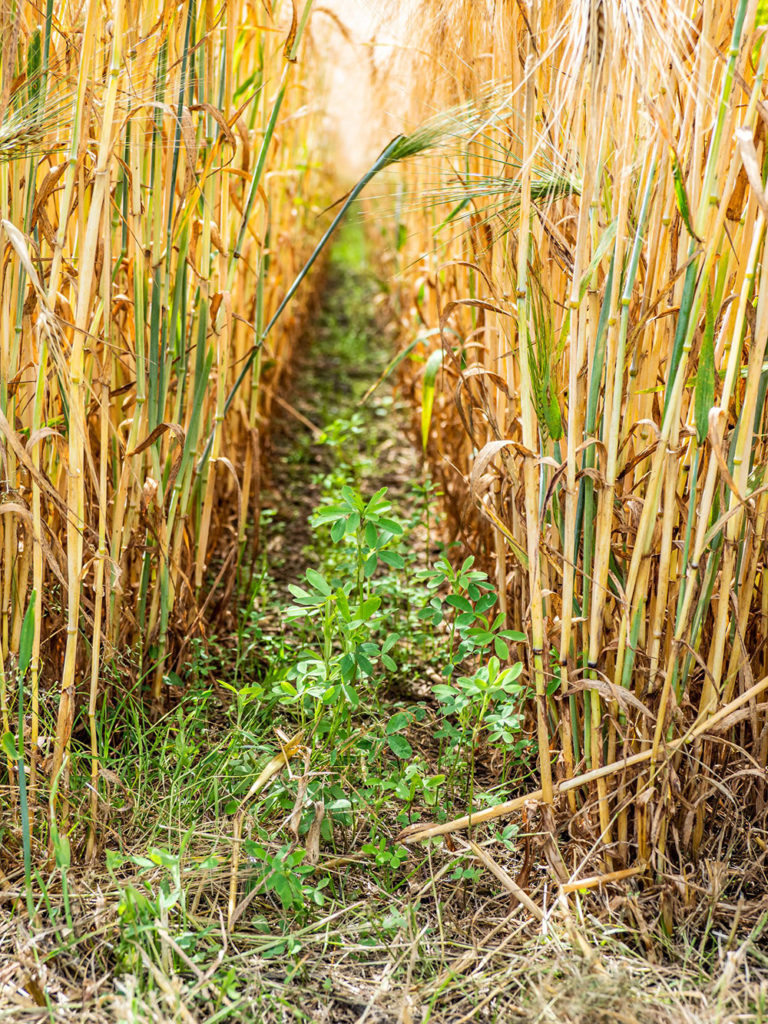
The following conclusions can be drawn from the key figures: Field emergence was between 92 % and 105 % (*), i.e. at a very high and comparable level.
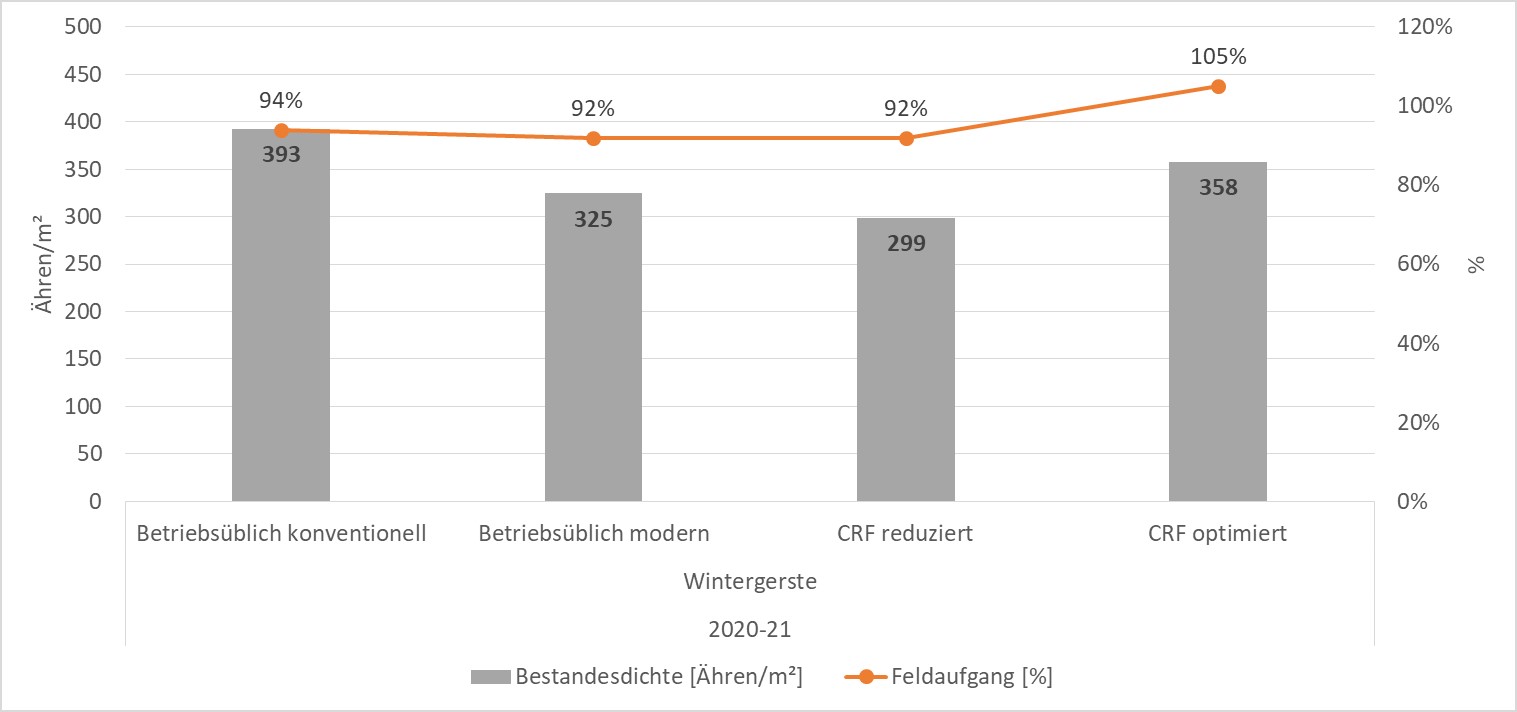
* Very good germination capacity and inaccuracies in metering or longitudinal and transverse distribution can lead to measured values > 100%.
Plant density shows the difference more clearly. Almost 400 ears / sq m are formed at high seed rates. The tillering rate is 1.3 (each plant forms 1.3 ears on average). The plant density n is up to 25% lower at the low seed rates of 155 gr/sq m. However, the winter barley formed more than two ears per plant on average.
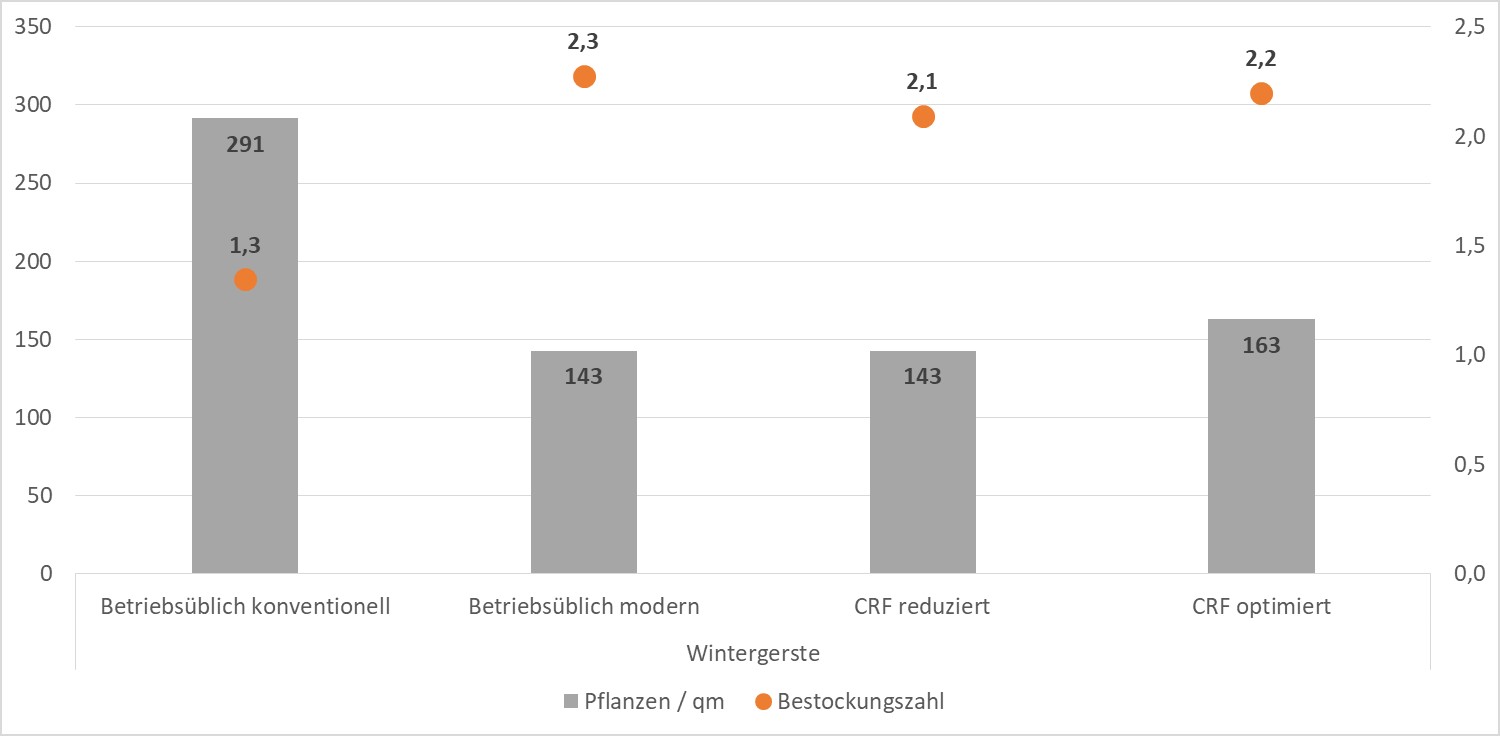
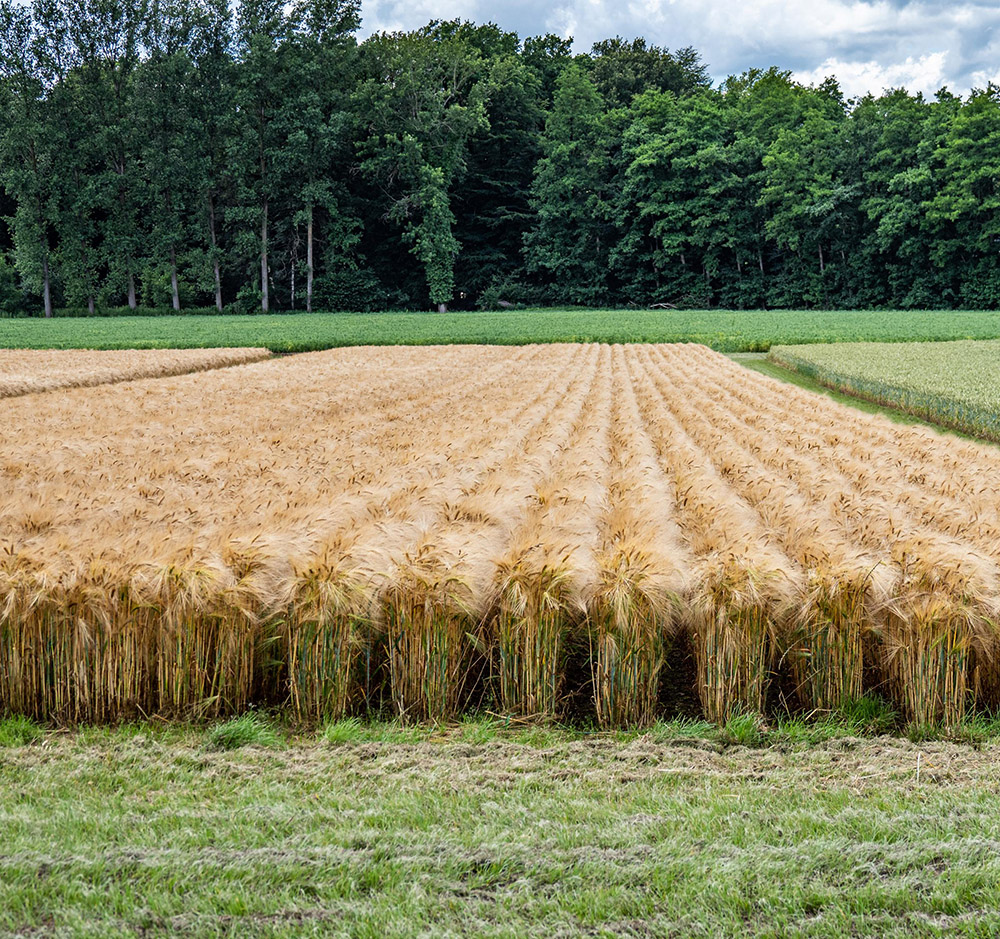
The winter barley was harvested on 24 July. The complete block of each variant was threshed and weighed. The yield of 78 dt/ha is average for the site and the region. The differences between the variants are so small that we can say that all variants produce uniform yields. The lower number of ears was obviously compensated for by stronger grain formation.


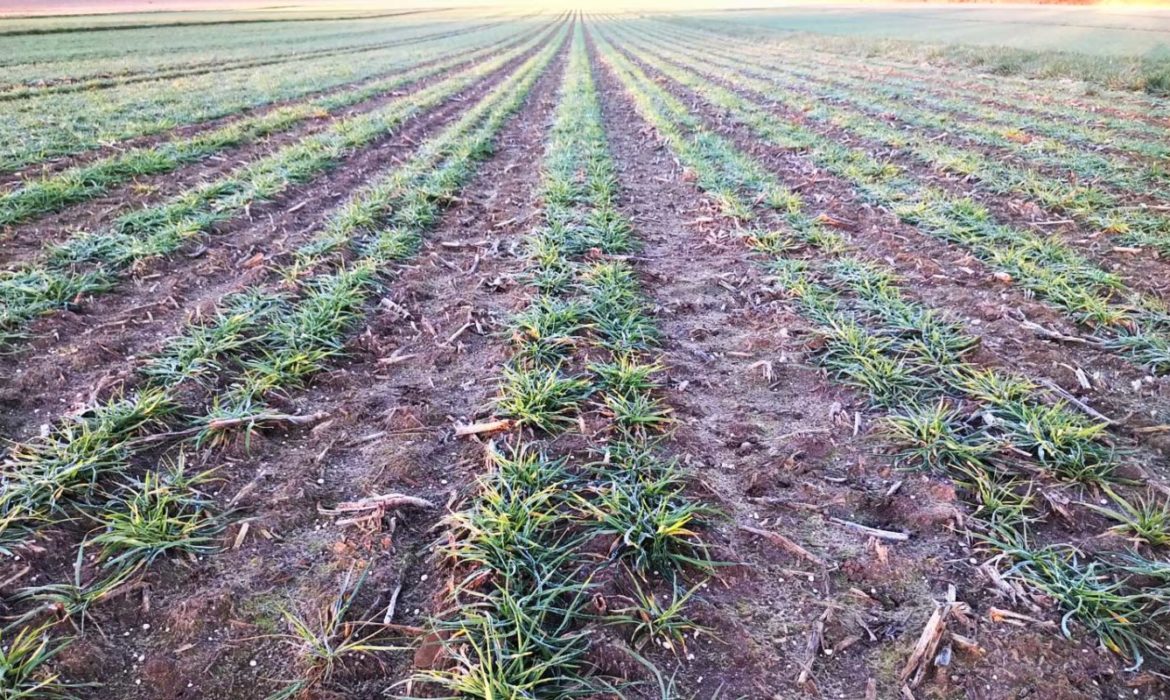
Autumn 2020: the limits of CRF become immediately apparent!
The establishment techniques for the CRF field trials are centred on rows 50 cm apart with hoeing and band spraying for uniform weed management. Unfortunately, we discovered that the use of hoeing systems for winter cereals in the autumn can pose a particular challenge.
The local weather station painted a very clear picture of the situation. September was relatively dry with only 38 mm of rainfall. A few days before the winter wheat and winter barley were sown, there was still some rainfall, which ensured that the conditions on 4th October were perfect. Large quantities of rain (105 mm in October) fell regularly over the following weeks, making use of the hoe impossible.
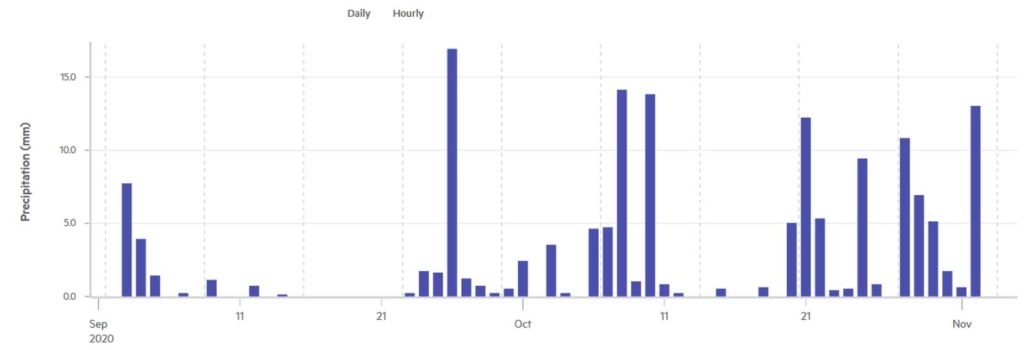
Due to a relatively high weed pressure, the decision was made to implement a herbicide programme over the entire area on 4th and 11th November.
The first pass to hoe and break up the capping will take place as soon as possible in the spring and the companion plants will be seeded in the same pass.
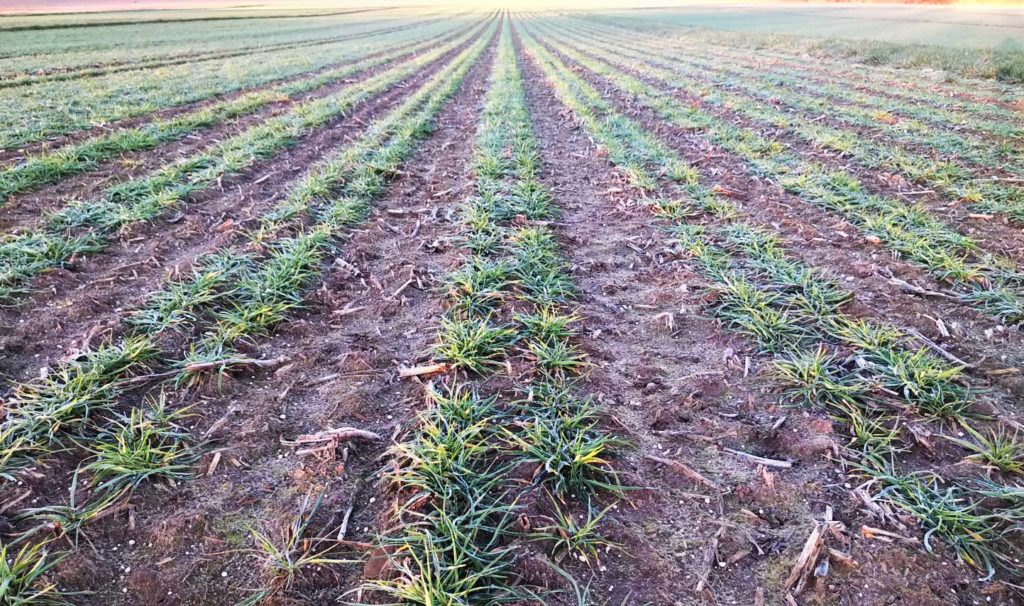
The crop appeared to be in prime condition before the vegetation started to grow. The rainfall from September to the start of March totalled almost 400 mm, giving us an ideal foundation for the perfect spring in 2021.
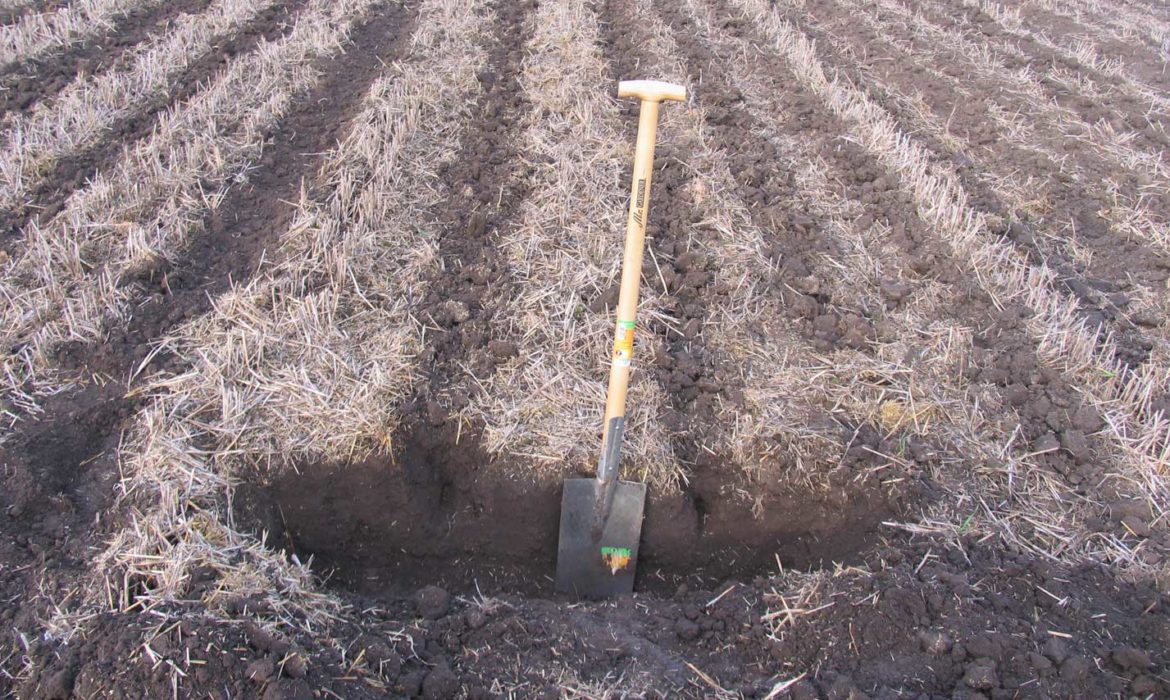
Strip-till in Controlled Row Farming – can it work?
The concept of Controlled Row Farming essentially involves basing every agricultural establishment and crop care measure around the plant rows. What is the “pure doctrine” of the CRF concept and what compromises have to be made in terms of location and weather? Needless to say, strip soil tillage (strip-till) played a role in the basic […]

